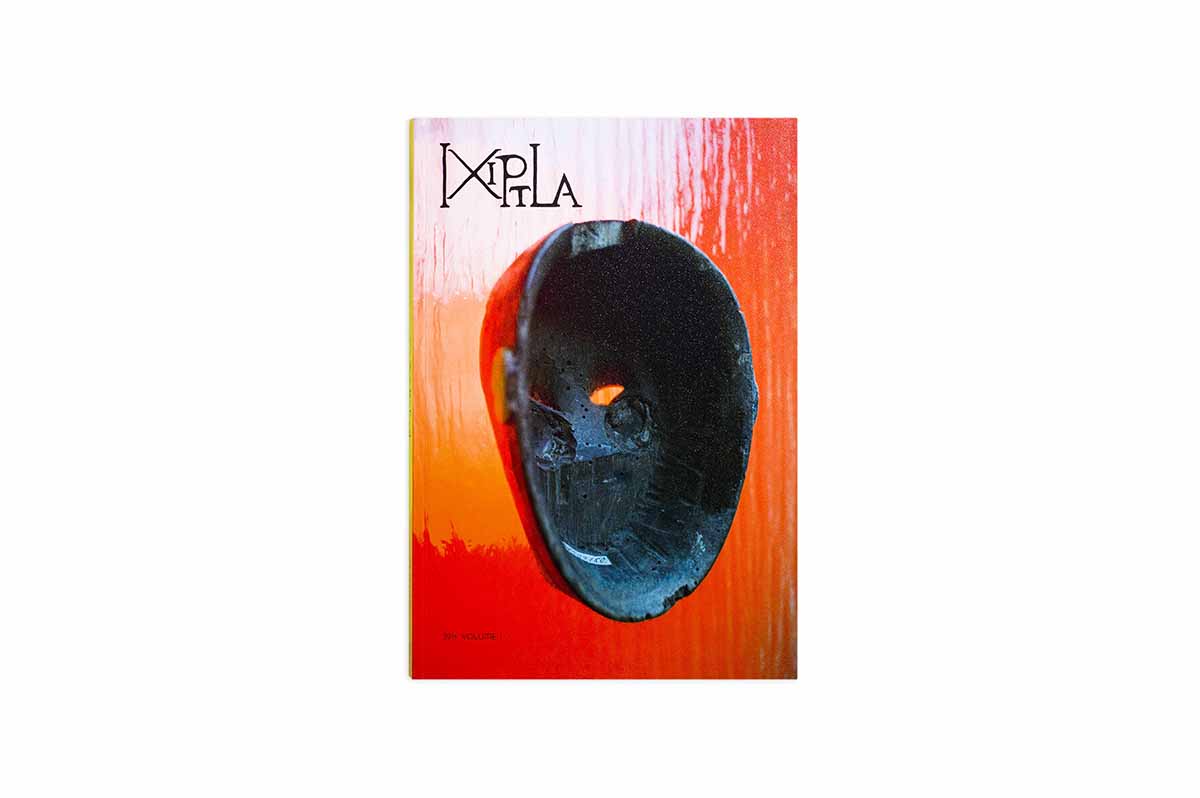Rituals of the Everyday
Collegium, Arévalo, Spain
Curator Clara M Kim
March 5 – September 1, 2024
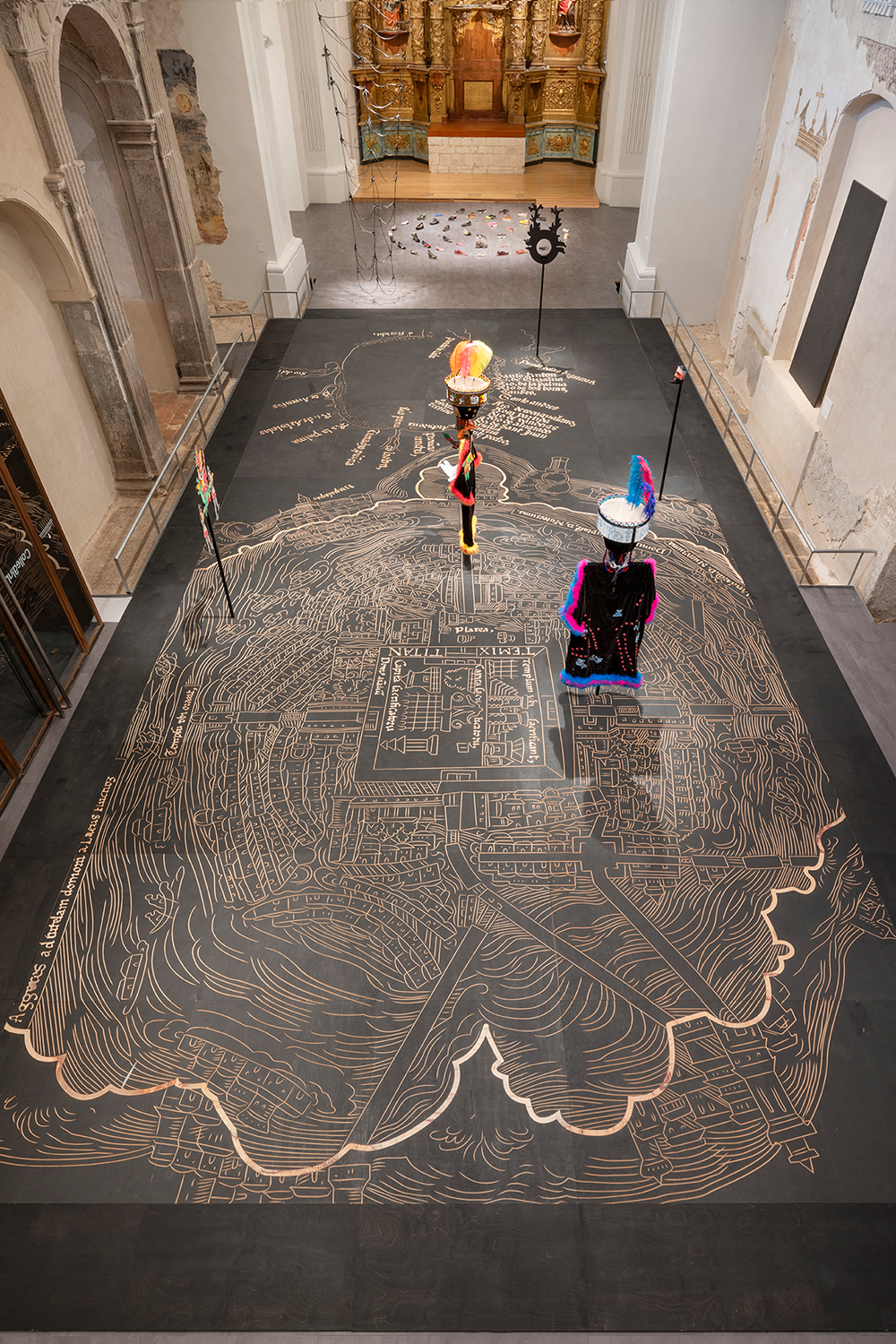
Installation view of “No acabarán mis flores”, 2013
Rituals of Everyday Exhibition at Collegium, Arévalo, Spain, March 5 – September 1, 2024
Curator Clara M Kim
Photograph courtesy of Studio Castillo Deball © Roberto Rulz
No acabarán mis flores, 2013
Nuremberg Map of Tenochtitlan, 2013
In 1521, a letter and two maps arrived in Spain for the Spanish king Charles V. This was the second of five letters that the conquistador Hernán Cortés sent describing the Aztec capital Tenochtitlán, which he and his crew had discovered and were near to conquering. One map was a detailed illustration of the city, and the other a sketch of the nearby Gulf of Mexico coast. The map of the city appears to reflect the conquistador’s view of Tenochtitlán as an enchanted metropolis: a jewel rising up from the center of an azure lake, housing an ordered, wealthy civilization, who were nevertheless misled in their predilection for heathen ritual sacrifice instead of enlightened Christianity.
This depiction of Tenochtitlán served to justify the expensive Spanish colonial efforts, but not only to Charles V, the king of Spain. The publication in Nuremberg of the map in 1524, along with the letter’s translation into Latin, also sparked the imagination and sup- port of a large European audience. This map was the first and the most widespread image that Europeans had of Tenochtitlán, and remains one of the few maps we have of the precolonial Aztec empire.
Some archaeologists now believe that the published map resulted from many copies made on the way from Mexico, through Spain, to Nuremberg, and that the original map was in fact drawn by an indigenous artist. The portrayal of rows of houses and the depiction of the island capital in the center of a circular lake is not only to be found in the European mapping tradition, but also in the Aztec one. The map also contains de- tails that were not mentioned in Cortés’s letters, such as Aztec historical and religious references, which were not understood by Europeans at the time.
The exhibition space is paved entirely in wood, engraved with the image of the Nuremberg map of Tenochtitlán. The wooden surface is also used as a matrix from which a one-to-one print of the engraved surface is made onto paper. The Atlas, a bound compilation of the prints.
Elements from Chinelo costumes seem to float in the space: a hat, a mask, some costumes, and decorative elements.
In colonial times, the Spaniards held splendid parties for Carnival, to which the indigenous population was not invited. They began to celebrate their own parties as satire, parodying the white people by donning pink masks with prominent bearded chins, and exaggerated costumes with ornaments made of cheap materials.
The “Brinco de los Chinelos” is a carnival traditional dance realized in various towns in the state of Morelos in Mexico where the dancers wear costumes depicting traditional, pagan, and popular imagery.
The motifs appearing on the costumes are based on images of the “Codex Tudela”, a colonial-era pictorial document held in the Museo de America in Madrid, it depicts and describes the traditions, celebrations, and rituals of Mexico before the conquest.

Installation view of “No acabarán mis flores”, 2013
Rituals of Everyday Exhibition at Collegium, Arévalo, Spain, March 5 – September 1, 2024
Curator Clara M Kim
Photograph courtesy of Studio Castillo Deball © Roberto Rulz
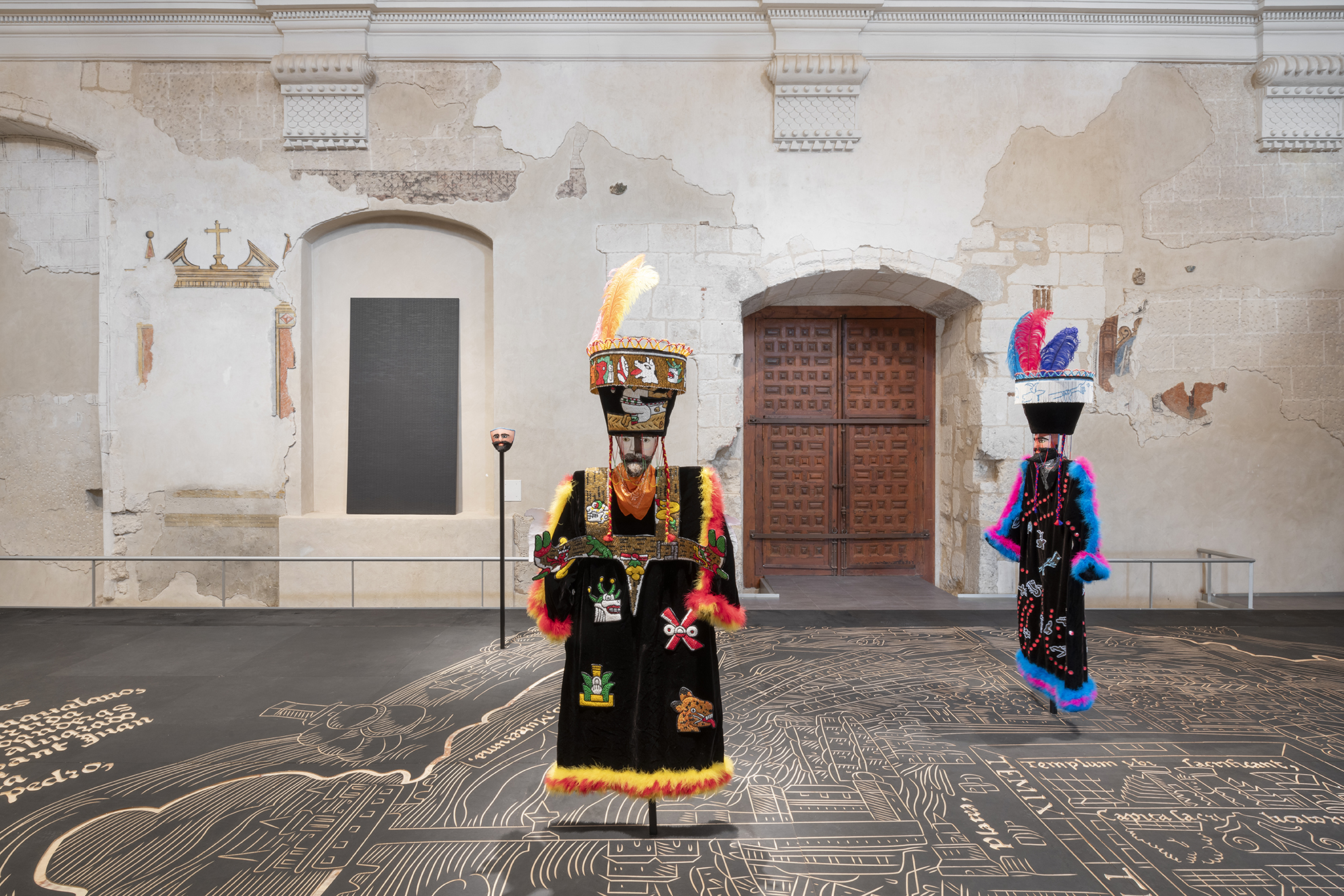
Installation view of “No acabarán mis flores”, 2013
Rituals of Everyday Exhibition at Collegium, Arévalo, Spain, March 5 – September 1, 2024
Curator Clara M Kim
Photograph courtesy of Studio Castillo Deball © Roberto Rulz
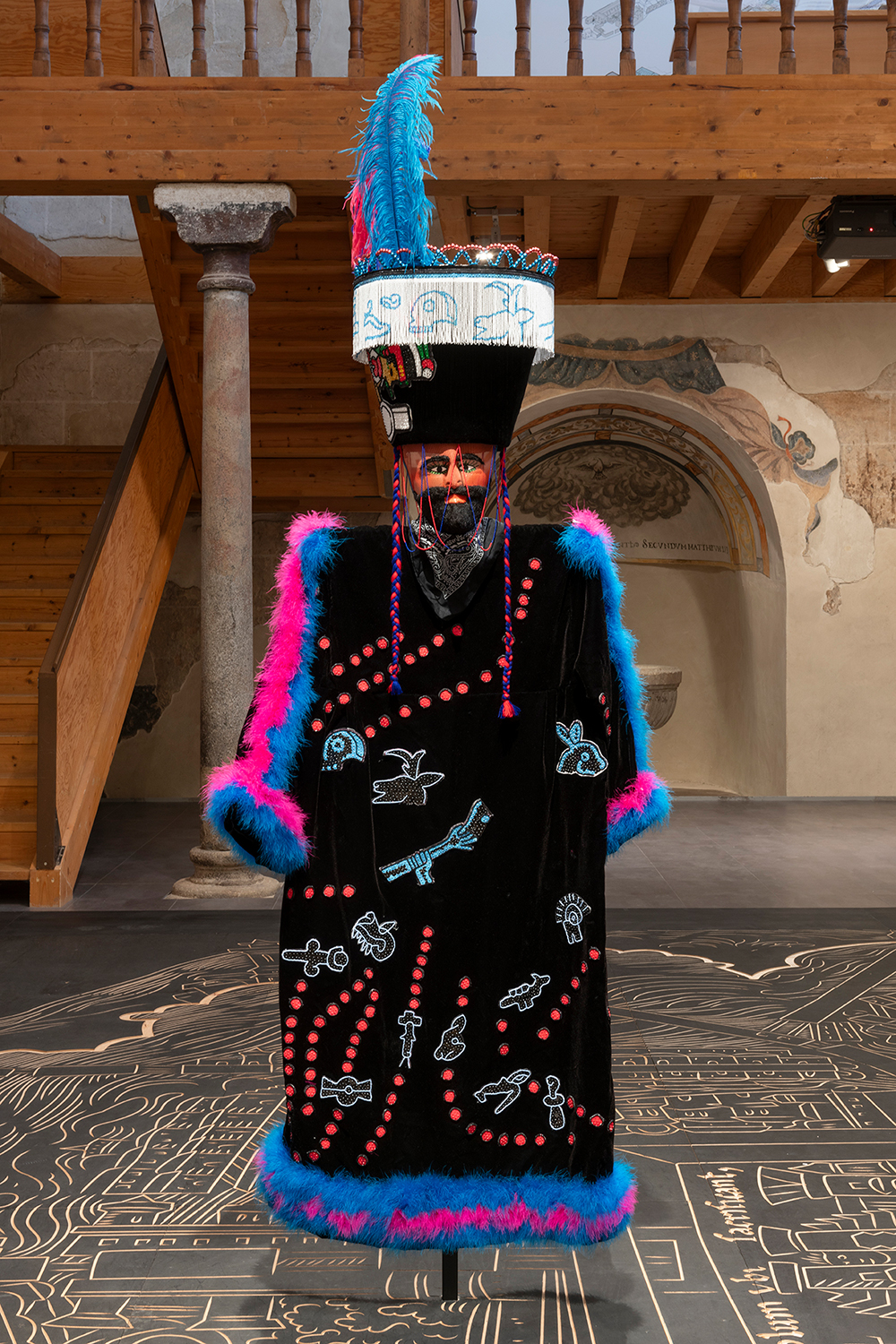
Installation view of “No acabarán mis flores”, 2013
Rituals of Everyday Exhibition at Collegium, Arévalo, Spain, March 5 – September 1, 2024
Curator Clara M Kim
Photograph courtesy of Studio Castillo Deball © Roberto Rulz

Installation view of “No acabarán mis flores”, 2013
Rituals of Everyday Exhibition at Collegium, Arévalo, Spain, March 5 – September 1, 2024
Curator Clara M Kim
Photograph courtesy of Studio Castillo Deball © Roberto Rulz

Installation view of “No acabarán mis flores”, 2013
Rituals of the Everyday exhibition at Collegium, Arévalo, Spain, March 5 – September 1, 2024
Curator Clara M Kim
Photograph courtesy of Studio Castillo Deball © Roberto Rulz
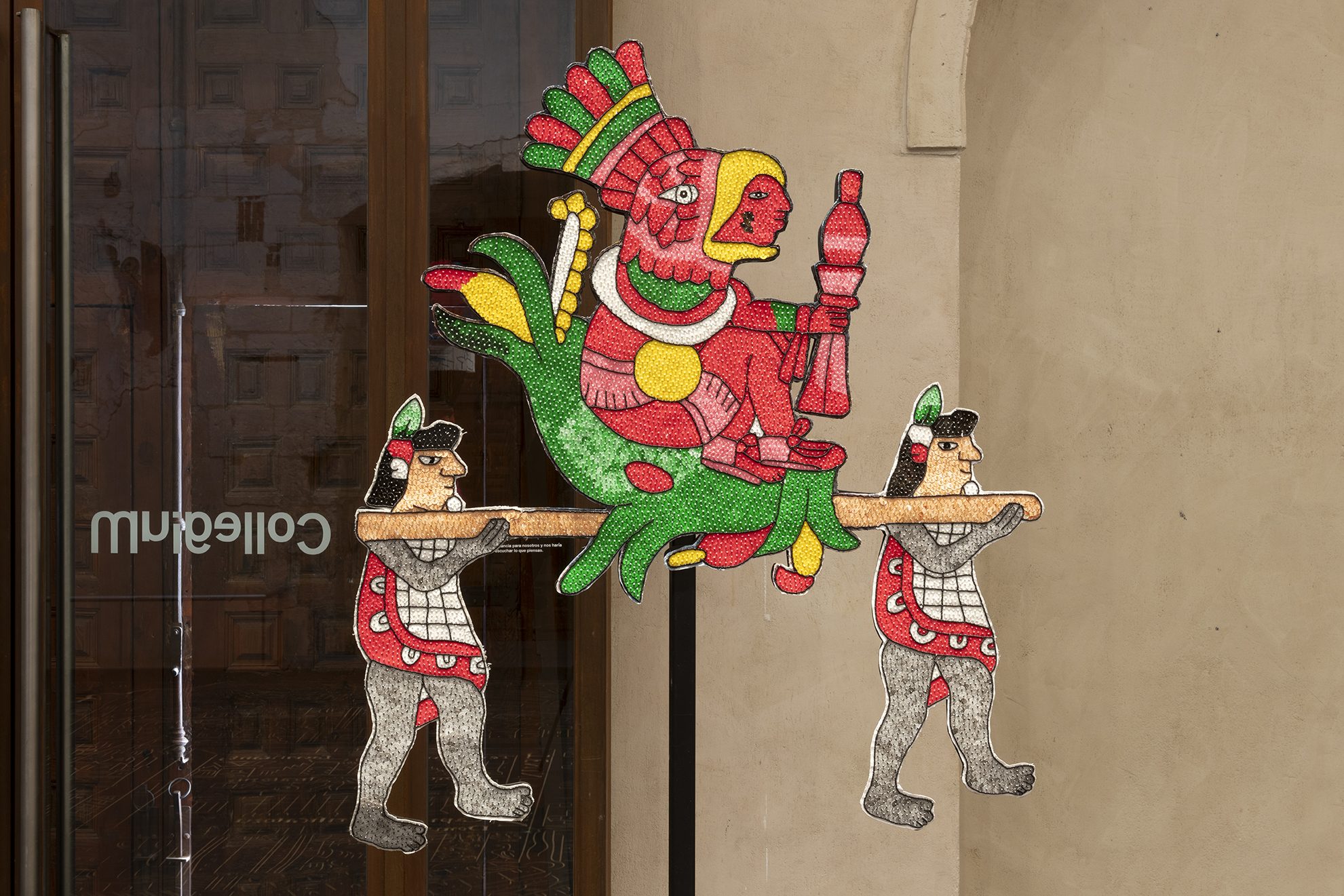
Installation view of “No acabarán mis flores”, 2013
Rituals of Everyday Exhibition at Collegium, Arévalo, Spain, March 5 – September 1, 2024
Curator Clara M Kim
Photograph courtesy of Studio Castillo Deball © Roberto Rulz
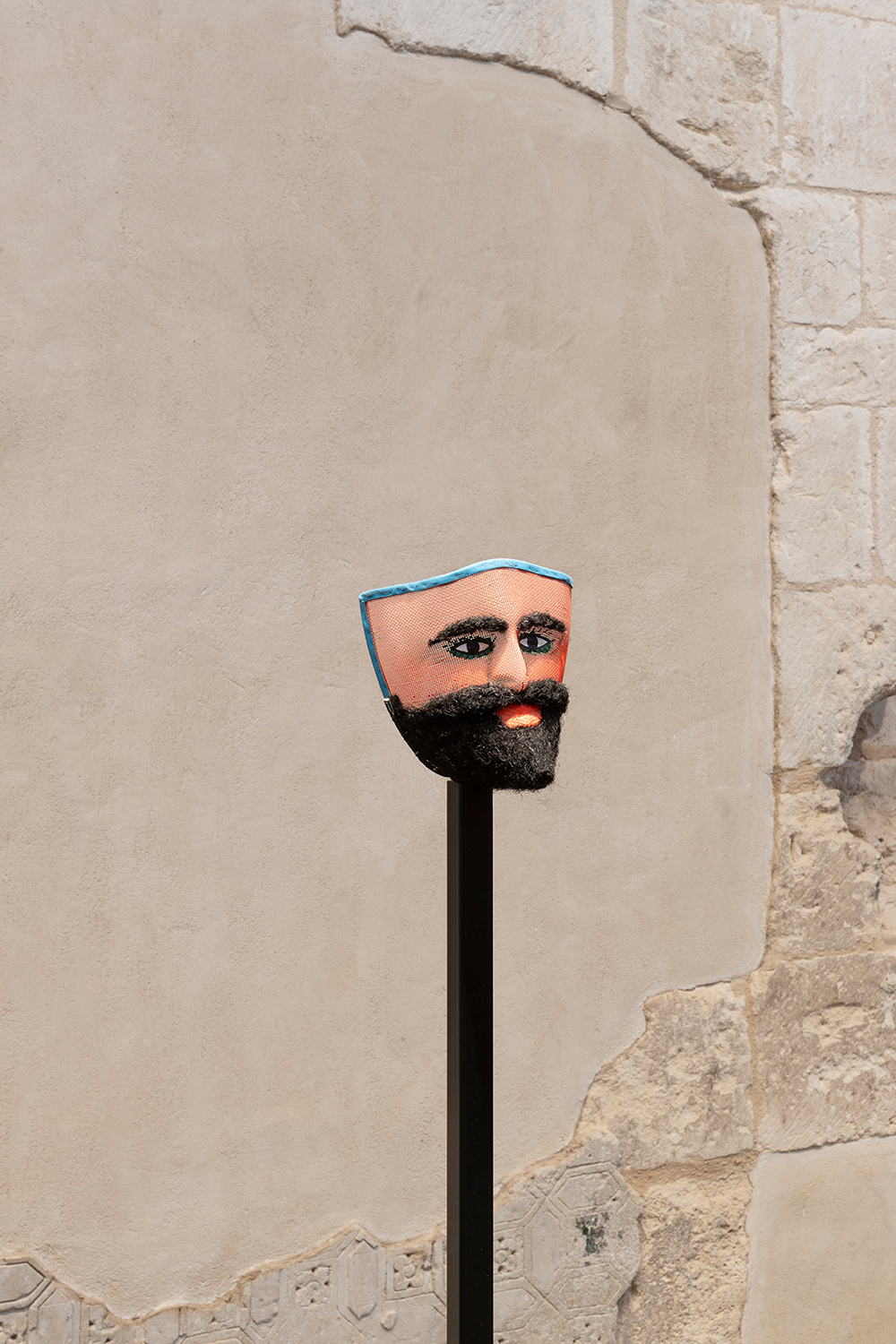
Installation view of “No acabarán mis flores”, 2013
Rituals of the Everyday exhibition at Collegium, Arévalo, Spain, March 5 – September 1, 2024
Curator Clara M Kim
Photograph courtesy of Studio Castillo Deball © Roberto Rulz

Installation view of “No acabarán mis flores”, 2013
Rituals of the Everyday exhibition at Collegium, Arévalo, Spain, March 5 – September 1, 2024
Curator Clara M Kim
Photograph courtesy of Studio Castillo Deball © Roberto Rulz
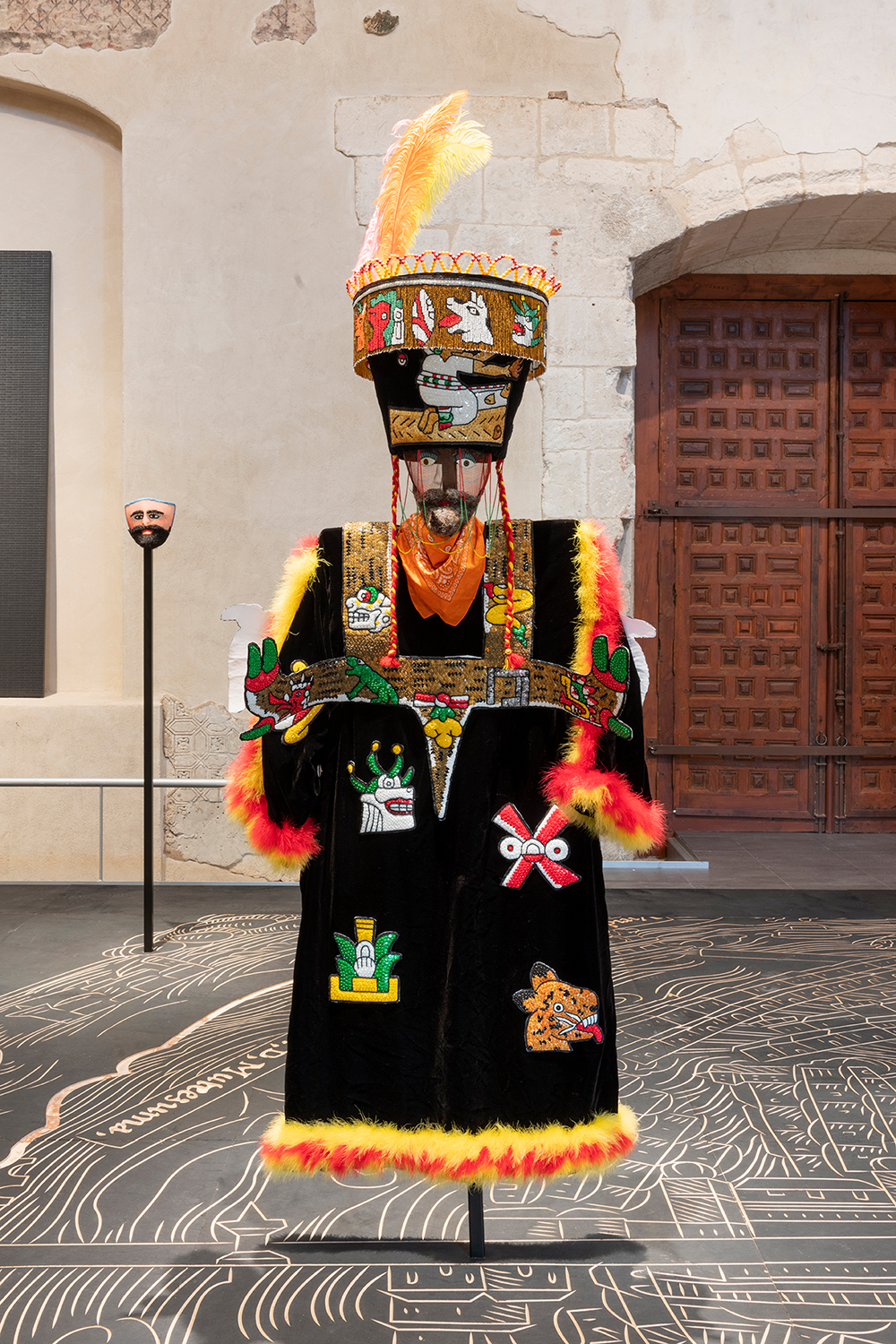
Hasta que los cantos broten (Until The Songs Spring)
Mexican Pavillion at the 59th international Art Exhibition of La Biennale di Venezia
Curated by Catalina Lozano and Mauricio Marcín
April 23 - November 14, 2022
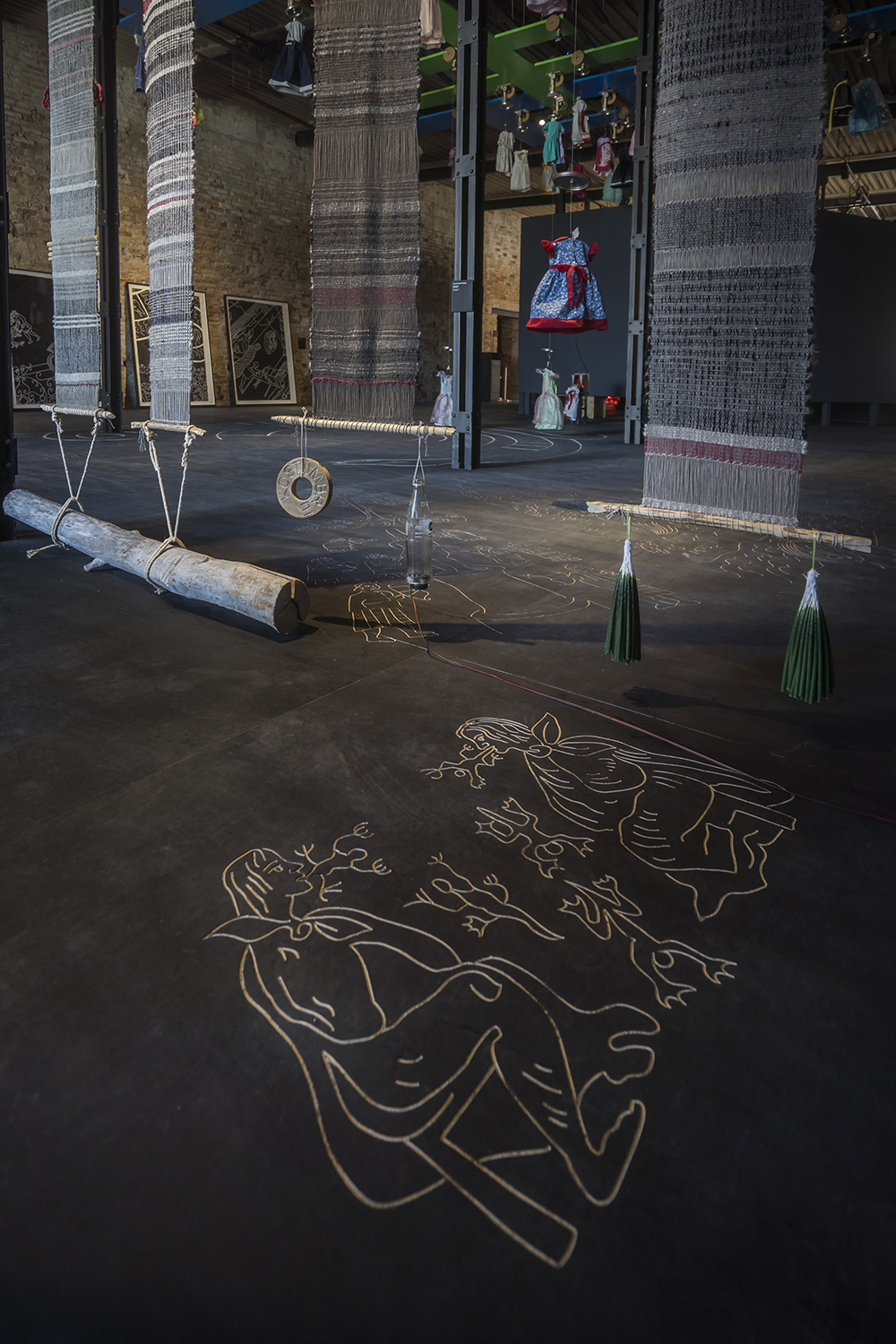
Installation view of Calendar Fall Away , 2022, CNC-engraved wooden floor, Variable dimensions, installation view in: Hasta que los cantos broten (Until The Songs Spring), 2022, Mexican Pavillion at the 59th international Art Exhibition of La Biennale di Venezia
Photo: INBA/WE EXHIBIT – Samuele Cherubini 2022
The works by Mariana Castillo Deball, Naomi Rincón Gallardo, Fernando Palma Rodríguez, and Santiago Borja (in collaboration with weavers of El Camino de los Altos) gathered in this exhibition deal with the tensions inherent to the existence of diverse life forms within a modern political construction such as the Nation-State.
This complex coexistence of different ways of understanding a territory and the relationships that make it emerge, produces often violent conflicts. This, in turn, yields diverse forms of resistance that express the ambition of the Ejército Zapatista de Liberación Nacional to create ‘a world where many worlds fit’: the pluriverse.
Until The Songs Spring is not a hypothesis, nor a manifestation of political alignment, but an effort to opening up to what becomes possible when ‘being with’, instead of just ‘being’, in order to shatter the naturalization of patriarchal forms of oppression expressed in violence, extractivism and racism.
Modernity has historically denied the discursive possibilities of all those ideas that seem opposed or incomprehensible within its own logic, in order to subject them to the hegemonic colonial rationality that also colonized our subjectivities. That is why this exhibition looks into heterogeneous forms of existence, alternative to the dominant canon, so that spaces to look, listen and learn differently can be unlocked.
Until The Songs Spring is a humble and limited intervention that outlines life’s plurality, symbiosis and mutualism; solidarities and paths traced while walking together.
Catalina Lozano and Mauricio Marcin
Calendar Fall Away is a large printing matrix that covers the entire floorspace of Mexico’s Pavilion. It reproduces a large drawing that invokes a series of references from experiences and documents derived from various ways of seeing and living in the world. To some extent, it captures and actualizes a specific historical episode, namely the early colonization of the territory we now call Mexico.
The drawing explores the influence of images produced in the Americas during the early colonization period and, at the same time, creates a new hybrid image that amalgamates various ways of understanding time and dealing with differences and the encounter dissimilar worlds in asymmetrical relations: an open calendar wheel whose inner elements spill outside the logic that a serpent used to secure; the illustrations of the alphabet by Diego de Valadés, a Tlaxcalan-Spanish friar who sought to evangelize and teach how to write and read to the Native peoples by mixing all sorts of references and creating a most probably absurd language for them; the paintings of the Uffizi Galleries where the images coming from the so-called ‘New World’ exerted a visible, but also subtle influence.
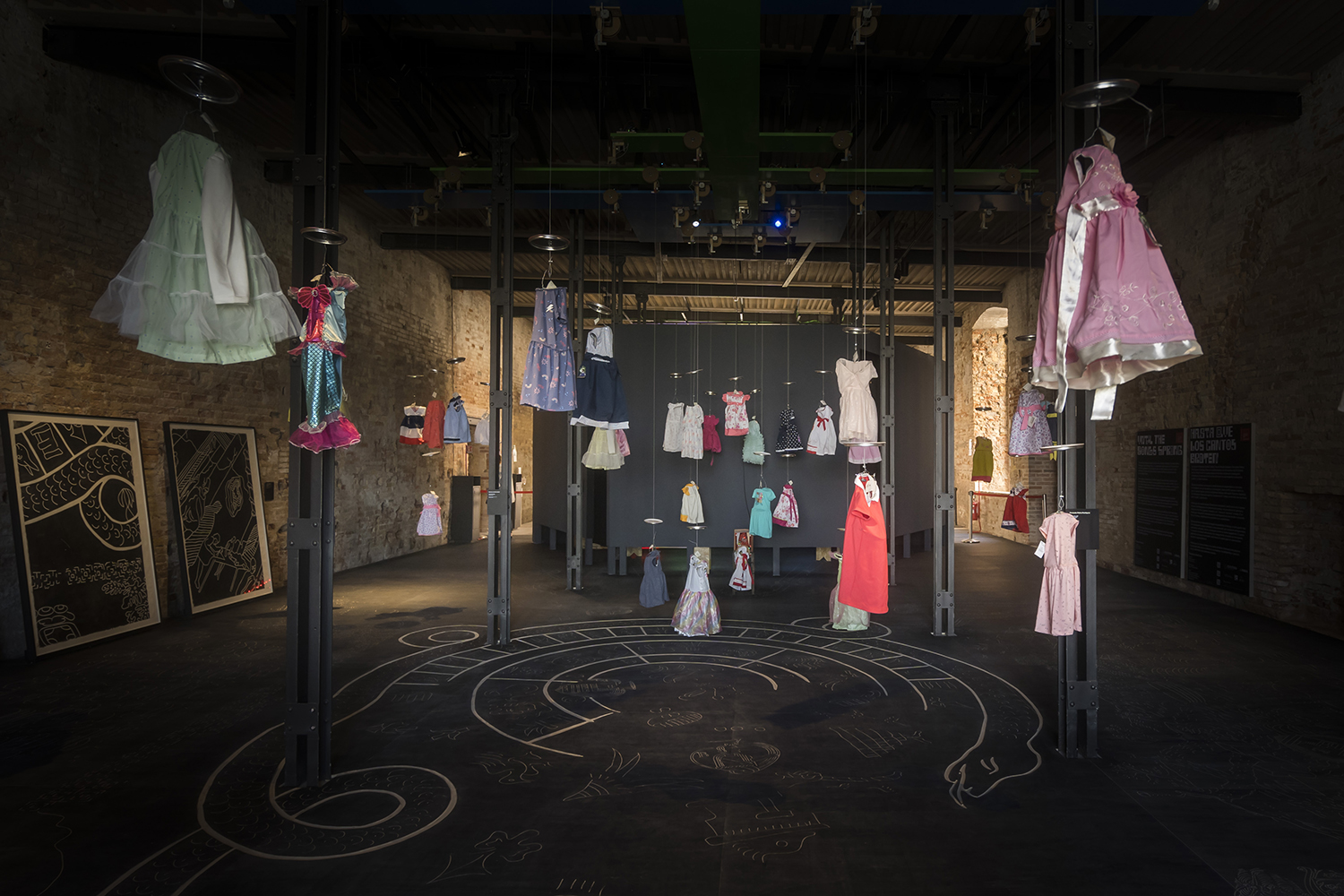
Hasta que los cantos broten (Until The Songs Spring), 2022, Mexican Pavillion at the 59th international Art Exhibition of La Biennale di Venezia
Photo: INBA/WE EXHIBIT – Samuele Cherubini 2022
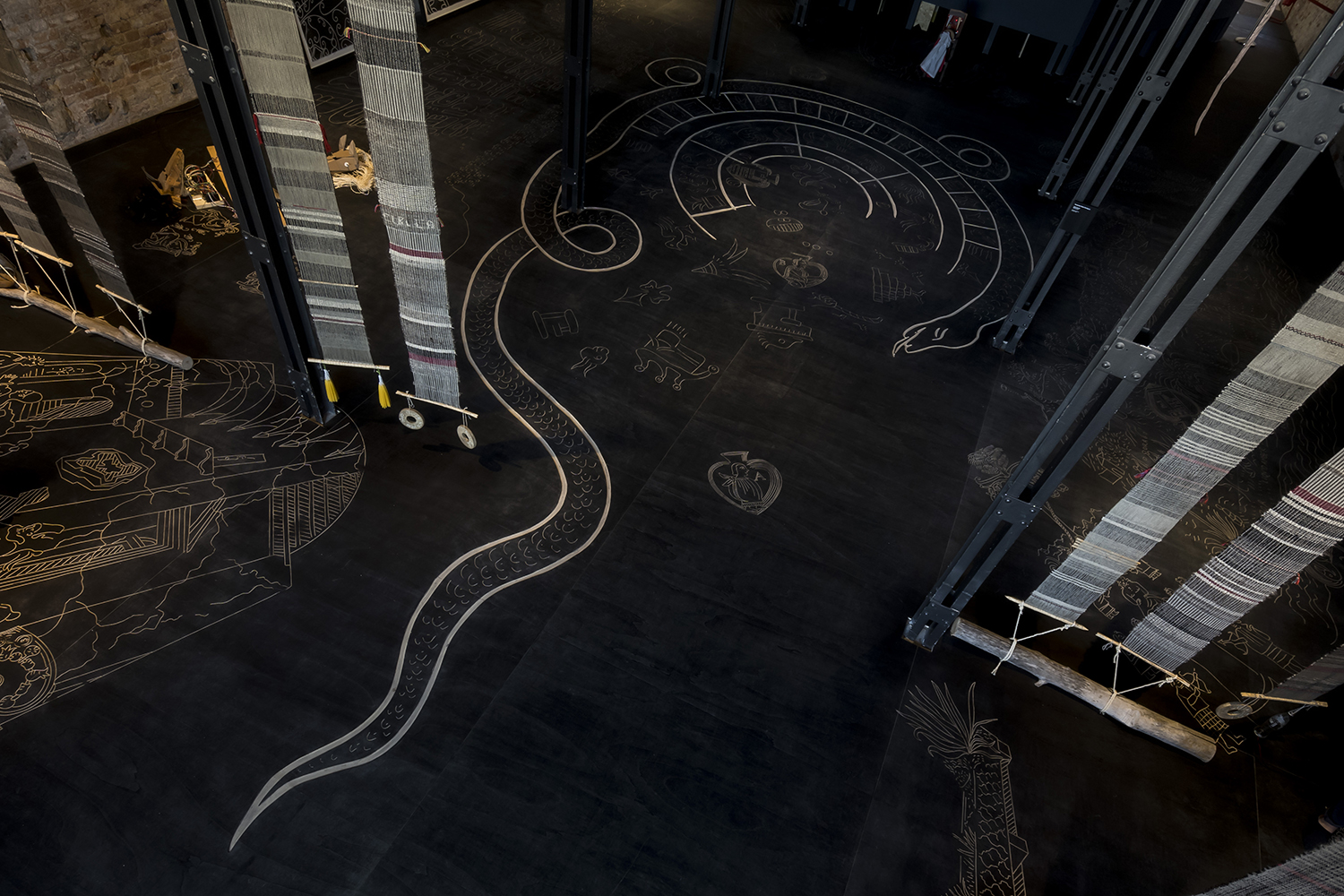
Installation view of Calendar Fall Away , 2022, CNC-engraved wooden floor, Variable dimensions, installation view in: Hasta que los cantos broten (Until The Songs Spring), 2022, Mexican Pavillion at the 59th international Art Exhibition of La Biennale di Venezia
Photo: INBA/WE EXHIBIT – Samuele Cherubini 2022
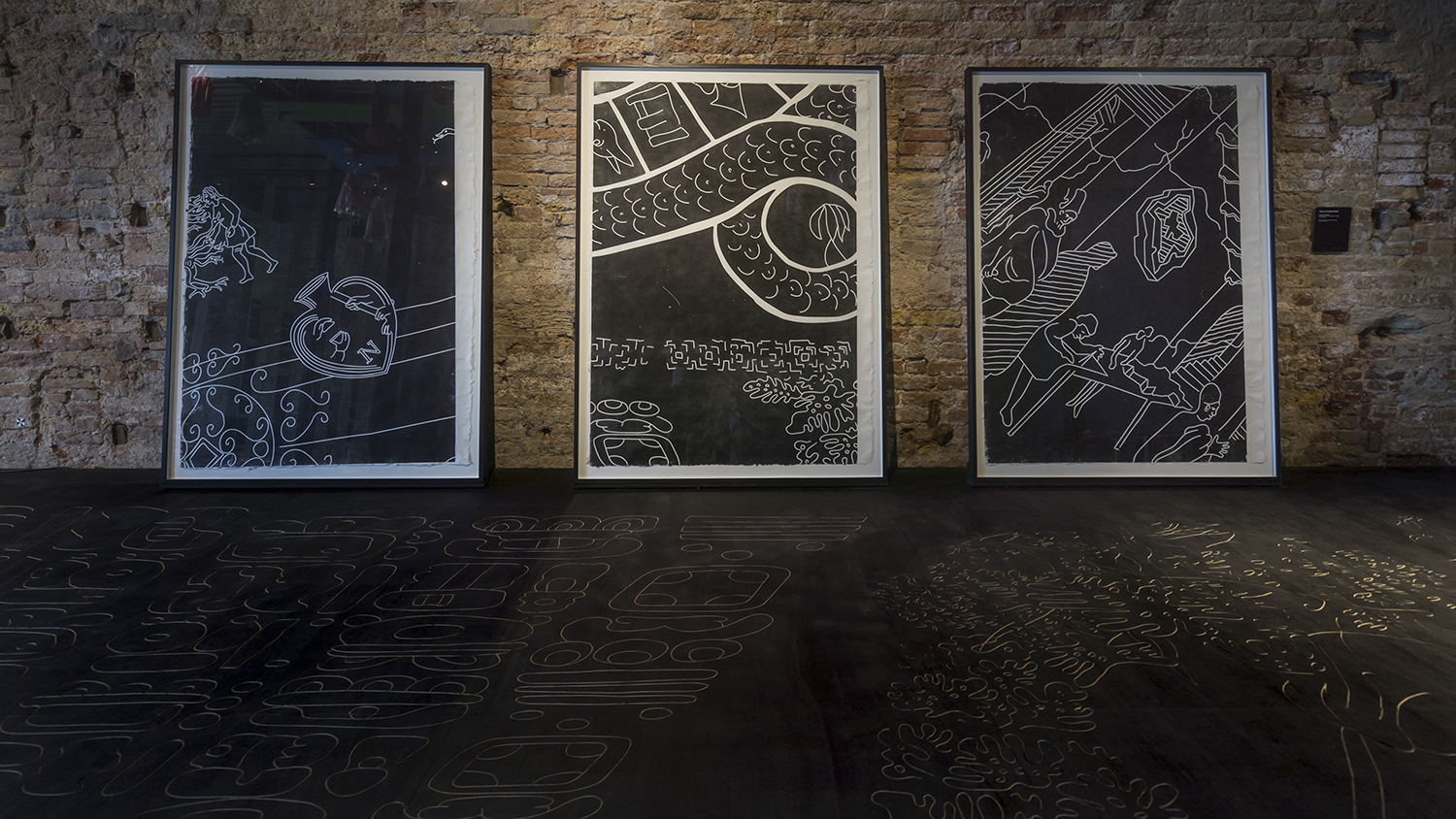
Installation view of Calendar Fall Away 85, 46 and 40, 2022, Woodcut print on Konzo and Abaca handmade paper, 124 x 181 cm, installation view in: Hasta que los cantos broten (Until The Songs Spring), 2022, Mexican Pavillion at the 59th international Art Exhibition of La Biennale di Venezia
Photo: INBA/WE EXHIBIT – Samuele Cherubini 2022
Finding Oneself Outside
New Museum, New York January 22 - April 14, 2019 Curated by Natalie Bell
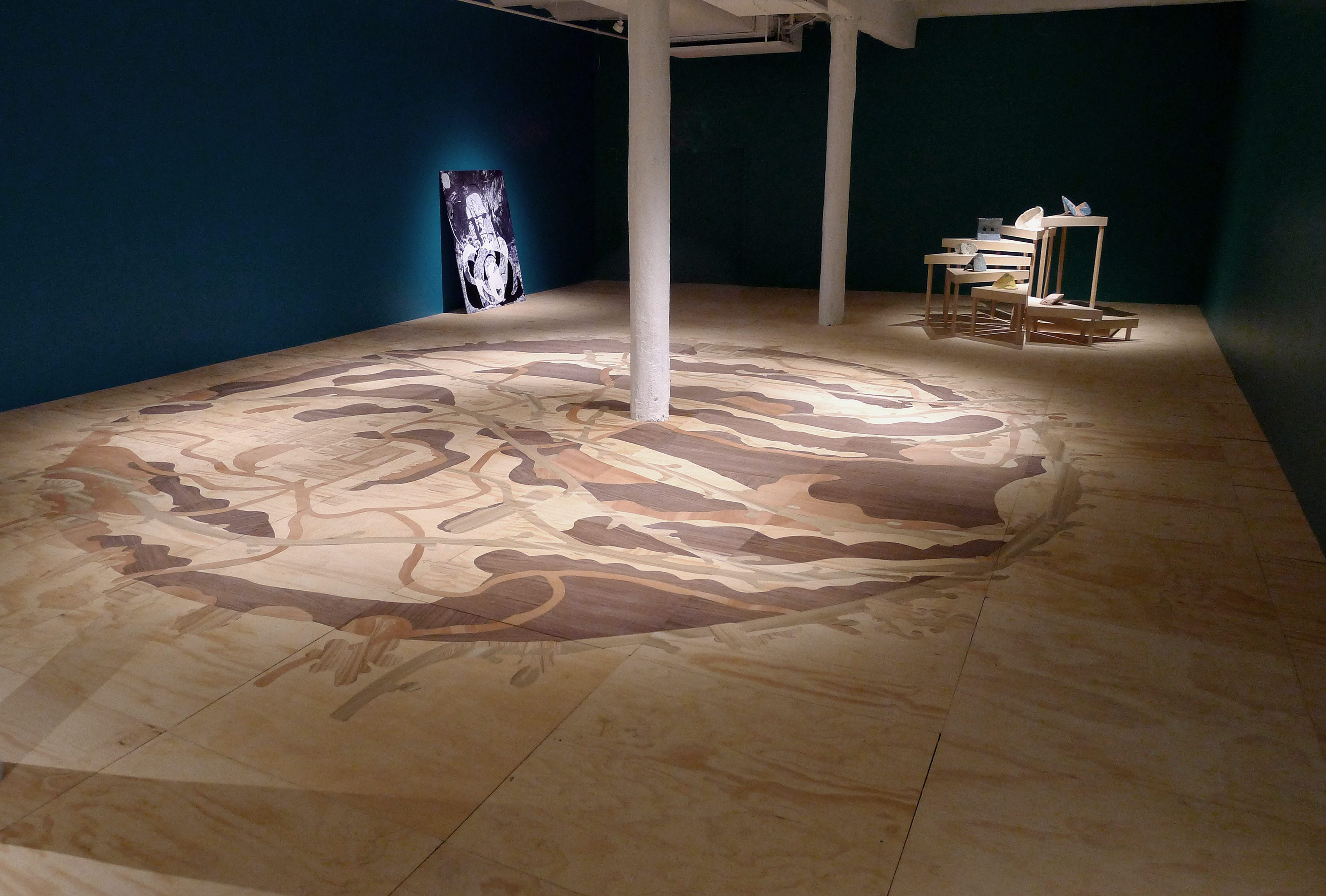
Installation view Finding Oneself Outside, New Museum, New York, USA 2019. Photo: Maris Hutchinson / EPW Studio
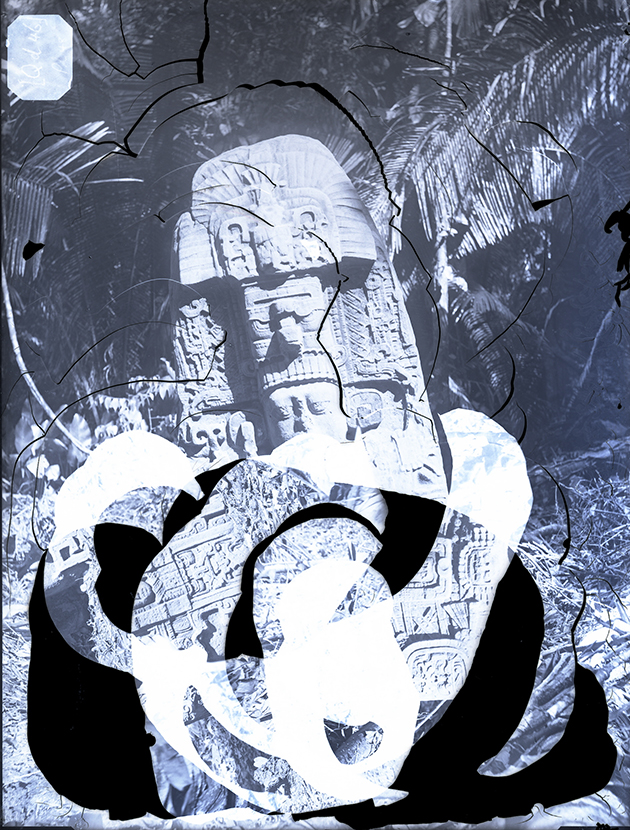
Stela K, Quiriguá
Damaged negative image of Stela K, Quiriguá, Guatemala. Dr Alfred Percival Maudslay,
1894 © The Trustees of the British Museum
Finding Oneself Outside, offers a possible description of a sensation that is central to both the study of history and the experience of encountering an unfamiliar culture. The exhibition’s centerpiece, a specially commissioned inlaid wood floor installation, draws from an early-colonial map of San Pedro Teozacoalco, Mexico, which bears a unique stylistic blend of European maps and Mixtec codices of the sixteenth century. A large-scale sculpture, No solid form can contain you (2010), offers a peculiar visualization of space as a would-be mold turned inside out—panels cast from a statue of Coatlicue, the Mexica, or Aztec, mother goddess, are inverted to reveal their concave sides and reassembled to create a hollow figure. Do ut des (2014–19), Castillo Deball’s series of perforated books, borrows its title from a Latin phrase meaning “I give so that you will give,” and her Mathematical Distortions (2012) refers to the shifts in knowledge that occur with shifts in position. Together, the works in the exhibition speak to the place of the viewer, the permeability of surfaces, and ideas of reciprocity and exchange.
Curated by Natalie Bell
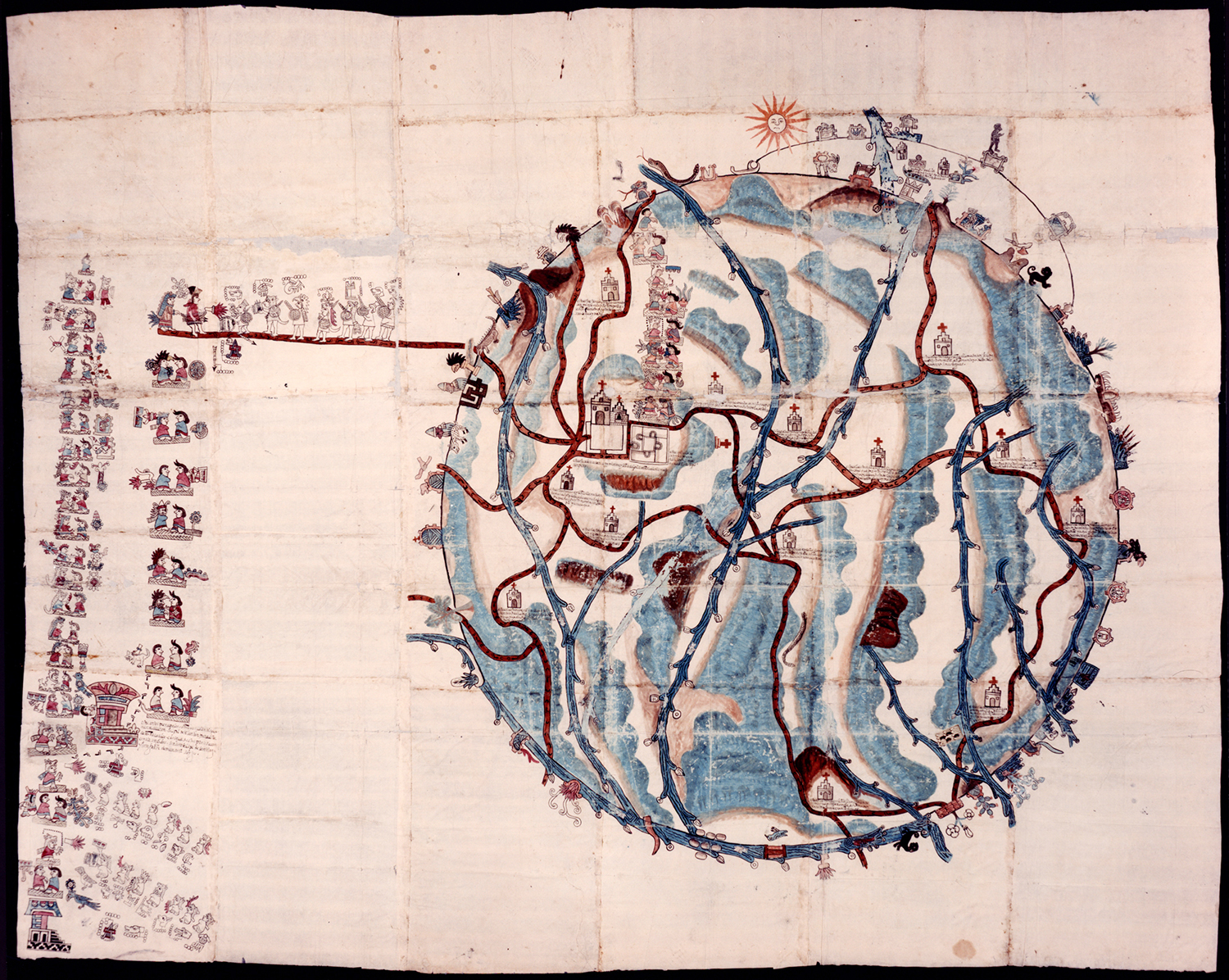
Map of Teozacoalco, 1580, San Pedro Teozacoalco, Oaxaca. European paper, 56 3/4 x 69 3/4 in (144 x 177 cm).
© Benson Latin American Library, University of Texas at Austin (read more)
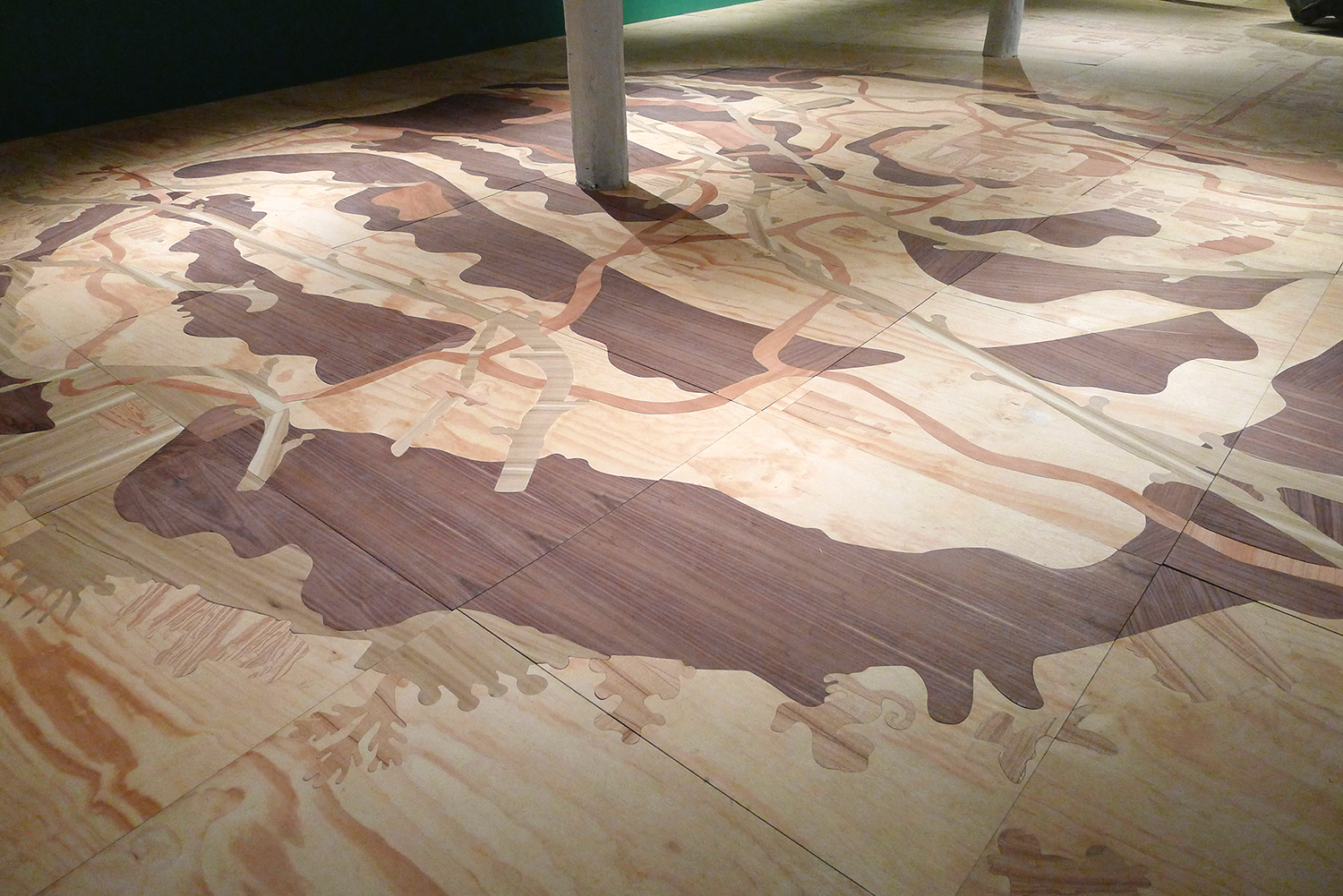
Teozacoalco Map, 2018
Inlaid wood floor installation with pine plywood, ash, poplar, red cedar, American walnut, and MDF
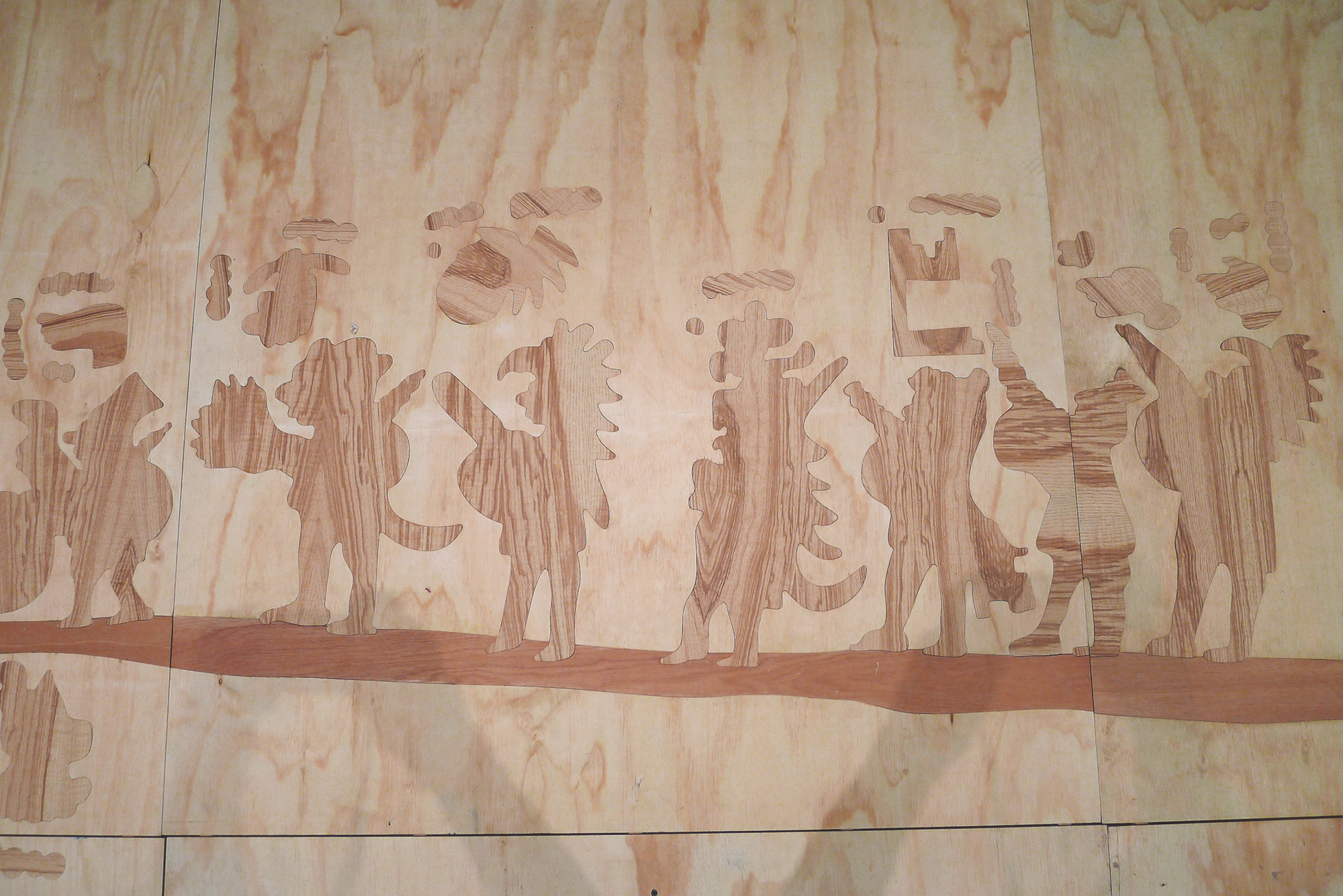
Detail: Teozacoalco Map, 2018
Inlaid wood floor installation with pine plywood, ash, poplar, red cedar, American walnut, and MDF
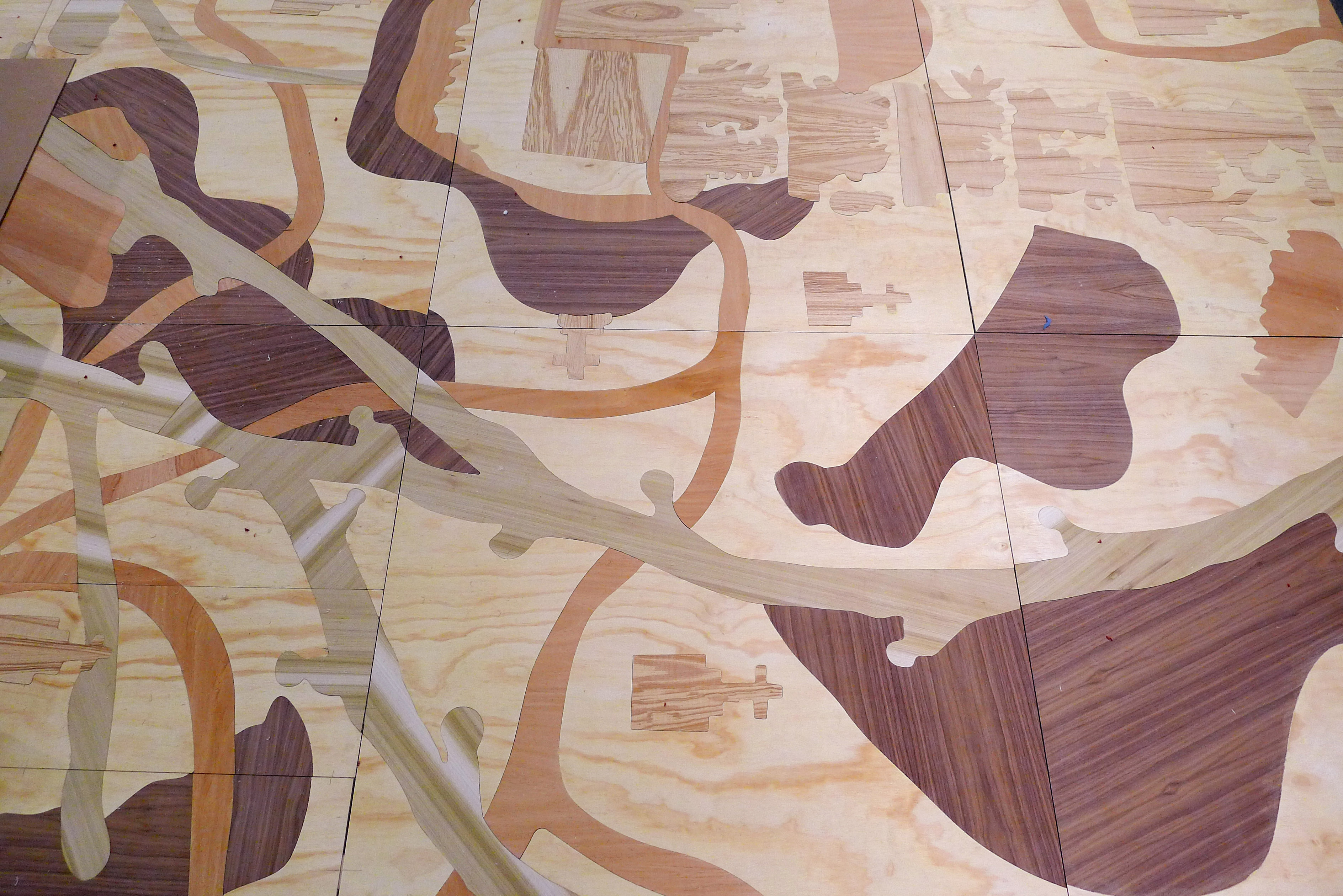
Detail: Teozacoalco Map, 2018
Inlaid wood floor installation with pine plywood, ash, poplar, red cedar, American walnut, and MDF
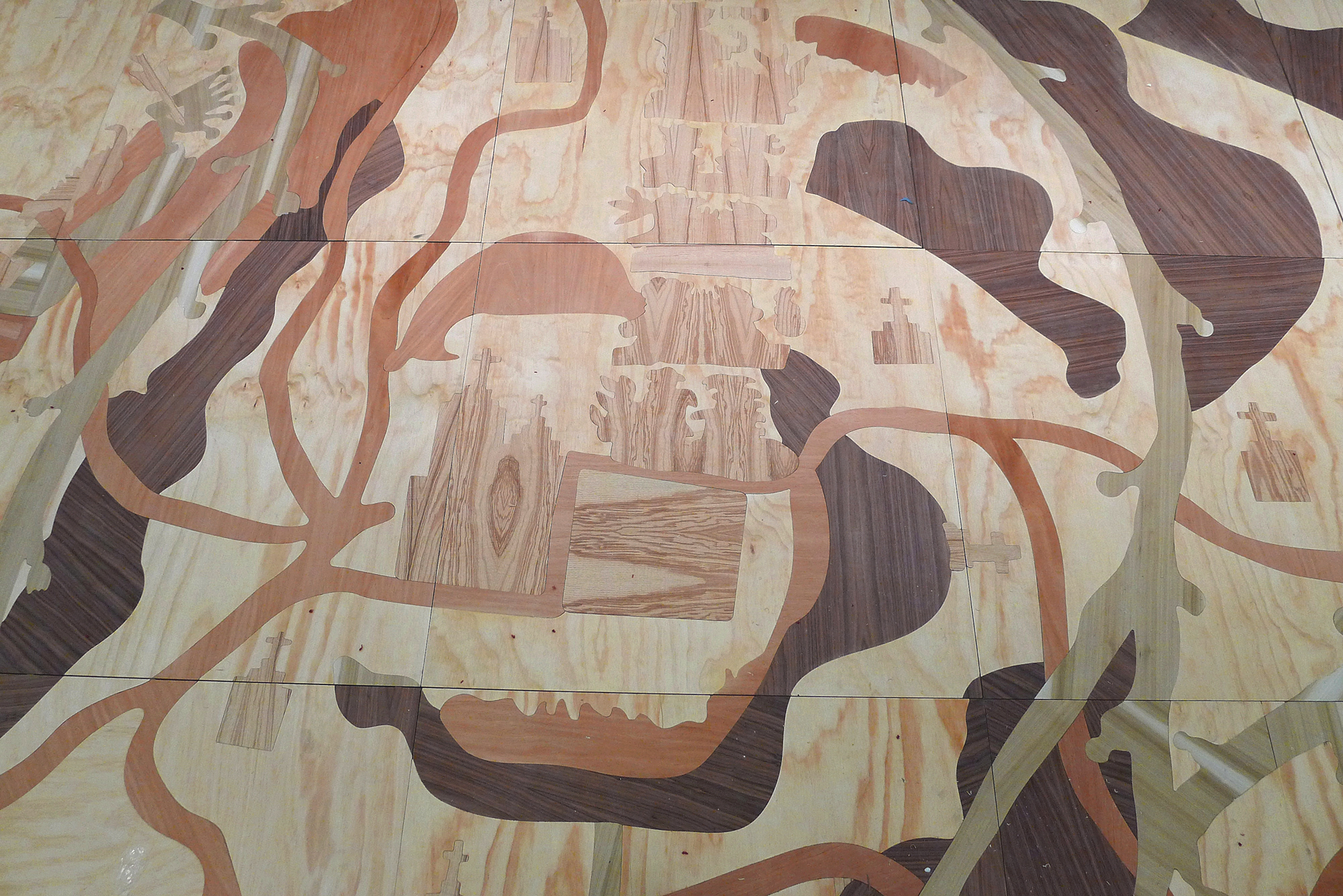
Detail: Teozacoalco Map, 2018
Inlaid wood floor installation with pine plywood, ash, poplar, red cedar, American walnut, and MDF
Originally serving as historical records, pictorial codices were produced by the Aztecs, the Maya, the Mixtecs, and other Mesoamerican peoples, but only about two dozen pre-Columbian codices have survived. The tradition, however, carried over into the colonial period, and these manuscripts, often taking the form of maps, are palimpsests of styles, techniques, and belief systems belonging to both the Mesoamerican people and the Spanish conquistadors. Teozacoalco Map (2019), an inlaid wood floor installation commissioned for this exhibition, is based on one such example, an early colonial map (c. 1580) of the town of San Pedro Teozacoalco, in Oaxaca, that was commissioned by the Spanish Crown as part of the Relaciones Geográficas, a series of questionnaires devised to collect data on daily life in the colonies. This work is part of a series of works in which early-colonial-era visual documents are enlarged and mapped onto the floor, such as Nuremberg Map of Tenochtitlan (2013), based on the eponymous map from 1524, and Vista de Ojos (2014), based on the Uppsala map from 1550.
The Map of Teozacoalco is fascinating in part because it represents not only a spatial domain but a temporal one as well, depicting the historical and mythical journeys of the people within it. While the author of the original map is unknown, some anthropologists have speculated that it was likely the product of collaboration between a Mixtec cartographer, or tlacuilo, and a colonial administrator, as the map bears a unique stylistic blend of European maps and Mixtec codices of the sixteenth century. The Map of Teozacoalco is also striking because it unveils a misunderstanding in what was actually being depicted of this place in New Spain: While the cartographer of the Spanish Crown had hoped for detailed records and maps made with astronomical references, what this map in fact offers is more a portrait of a community—a people and a past—than a simple survey of land.
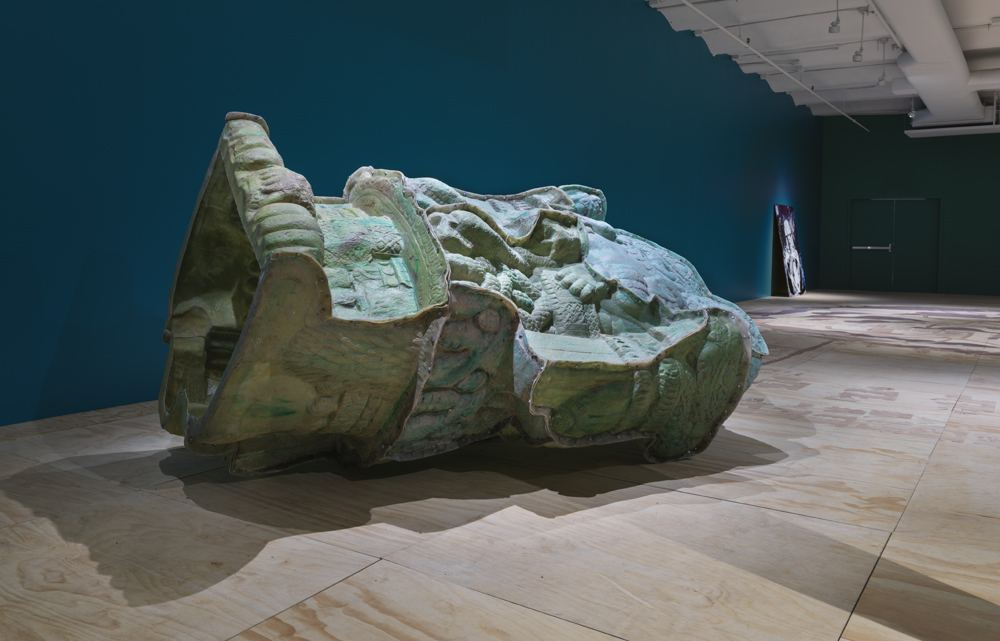
No solid form can contain you, 2010
Fiber glass sculpture from a cast of the original Coatlicue statue
. Photo: Maris Hutchinson / EPW Studio.
The Story of Coatlicue and Coyolxauhqui
Adorning archaeological objects, the figures Coatlicue and Coyolxauhqui represent the deities of the Earth/ Death and the Moon in Mexica (Aztec) mythology, respectively. Both have a complex history, especially in relation to the many literal and figurative spaces they have occupied—as physical sculptures as well as mythical characters in their own right—in the collective imagination, as well as in museums, public squares, and political rhetoric.
The symbolism of Coatlicue is of course tied to the myths that surround her. The goddess Coatlicue was the mother of Coyolxauhqui (the Moon) and four hundred sons (the Stars). One day, Coatlicue became mysteriously pregnant, this enraged her daughter Coyolxauhqui who convinced her brothers to plot murderous vengeance against their mother. Coatlicue was in fact pregnant with Huitzilopochtli (the Sun), and was patiently awaiting his arrival, unaware of the conspiracy against her.
When the Moon and the Stars finally attempted to kill Coatlicue, Huitzilopochtli emerged from his mother’s womb to defend her. The Sun decapitated his sister, the Moon, and tossed her down a mountain. Her body was dispersed—arms over here, legs over there—hence the figure of Coyolxauhqui is that of a dismembered woman. The story of the Sun’s victory is the story of a new concept of time that arose within Aztec thought: a time based on war and human sacrifice, which are required for the sun to return every morning. Through the sacrifice of the Moon, the repetition of the cycle—and the Sun’s assured victory each morning—is guaranteed.
Mariana Castillo Deball
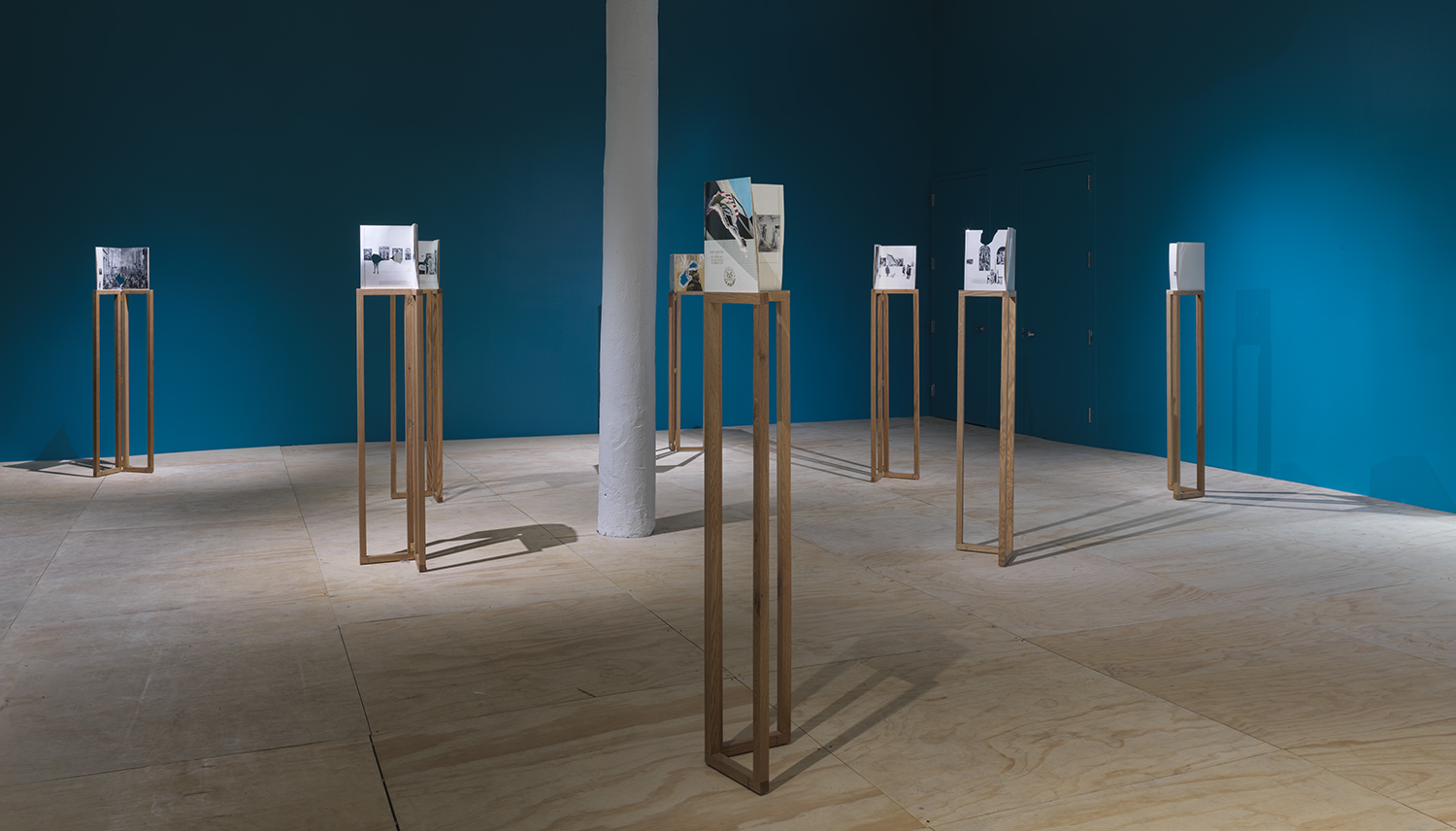
Do Ut Des, ongoing series of drilled books. From the collection called “The museums of the world”
Installation view Finding Oneself Outside, New Museum, New York, 2019
. Photo: Maris Hutchinson / EPW Studio.

Do Ut Des, ongoing series of drilled books. From the collection called “The museums of the world”.
The series of works Do ut des (2014–19), alludes to the creative potential of estrangement and the interdependence of art and its viewers, as evoked by the title borrowed from a Latin phrase meaning, “I give so that you will give.” In this ongoing body of work, Castillo Deball bores holes and cavities in a series of books from the late 1960s called El Mundo de Los Museos (The world of museums) conceived by Brazilian designer Eugênio Hirsch. Each book features works from a particular institution’s collection, shown in relation to a human figure, revealing to the reader the perspective and scale on which a hypothetical viewer would encounter these works in a museum.
The excavations into these books double as Rorschach-like cross sections, which contrast the works visible on the books’ pages. Unlike the works housed in these museums’ collections, which demand a certain art historical knowledge on the part of the viewer, there is little prerequisite knowledge of cultural codes or symbols required for the interpretation of these ambiguous shapes. As the artist views it, these forms appeal instead to the imaginative process that is at the root of creative interpretation. As she sees it, a similar oscillation between knowing and not knowing generates a sense of estrangement that is essential to the creative process, both for artists and for viewers, because it allows for the possibility of new interpretations and correspondences between works and ideas.

Detail: Do Ut Des, ongoing series of drilled books. From the collection called “The museums of the world”.
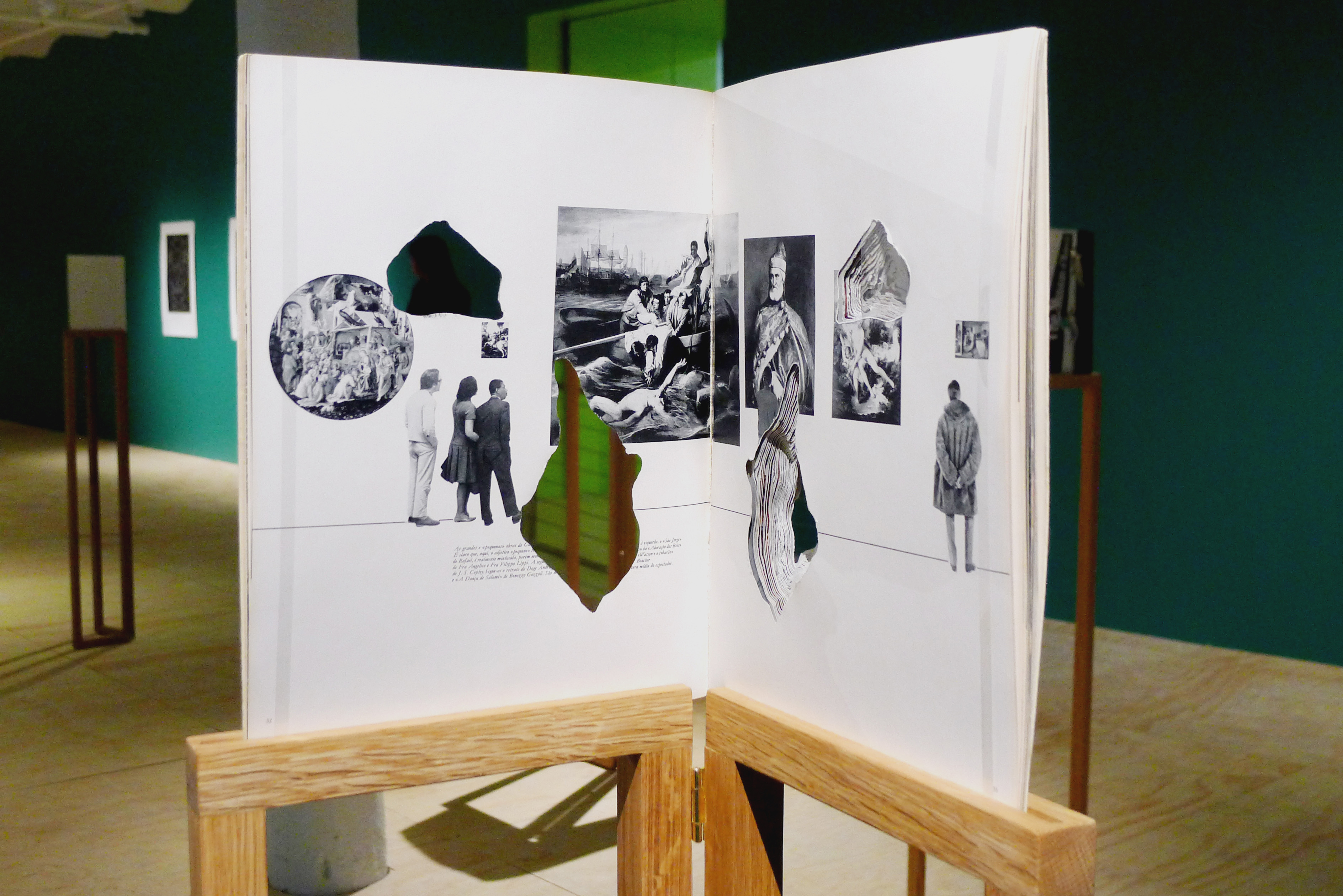
Detail: Do Ut Des, ongoing series of drilled books. From the collection called “The museums of the world”
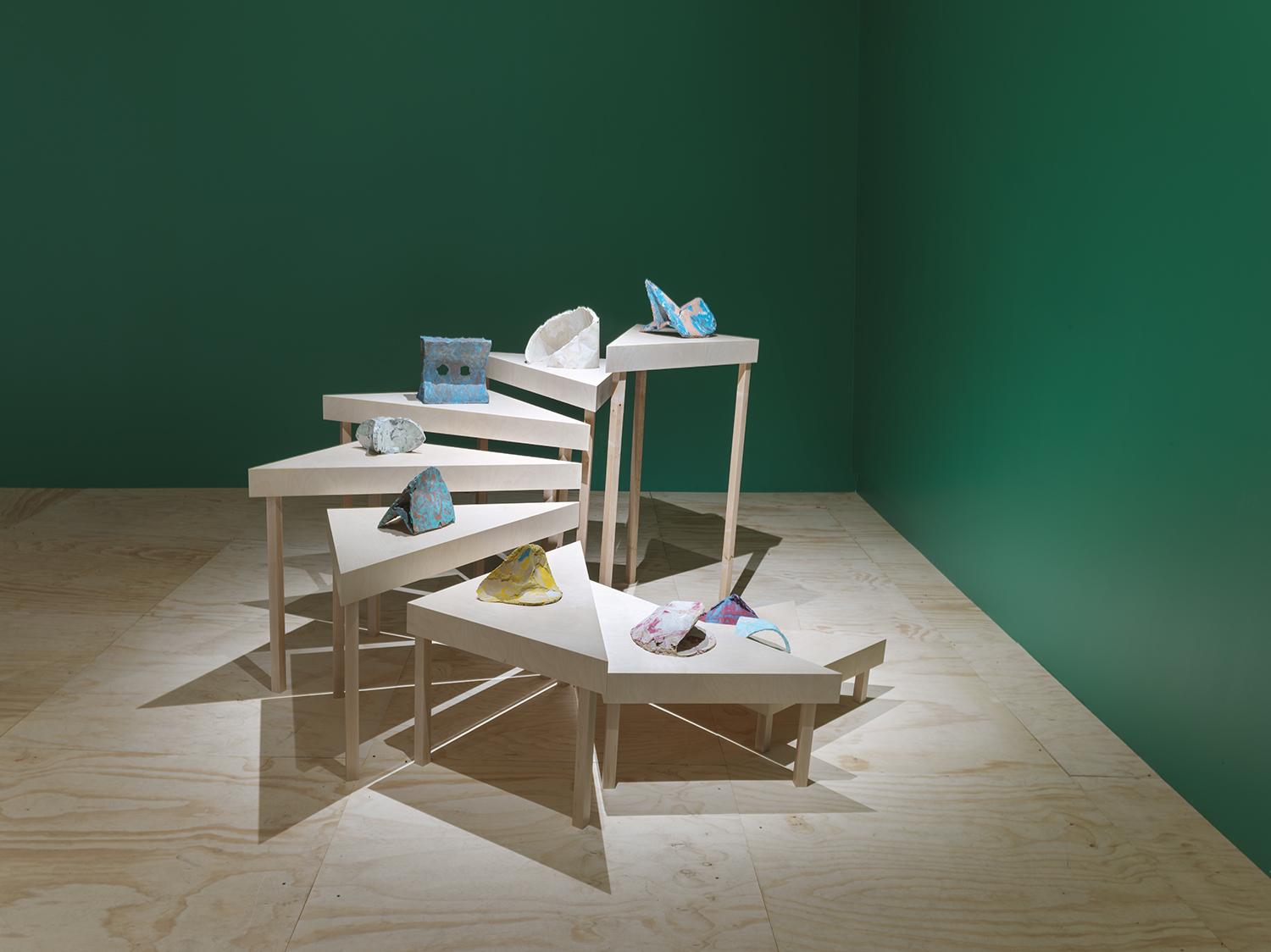
Mathematical distortions (nos. 1, 6, 7, 8, 9, 10, 12, 15, 17), 2012
Plaster, pigments, rabbit glue, and aluminum.
Photo: Maris Hutchinson / EPW Studio
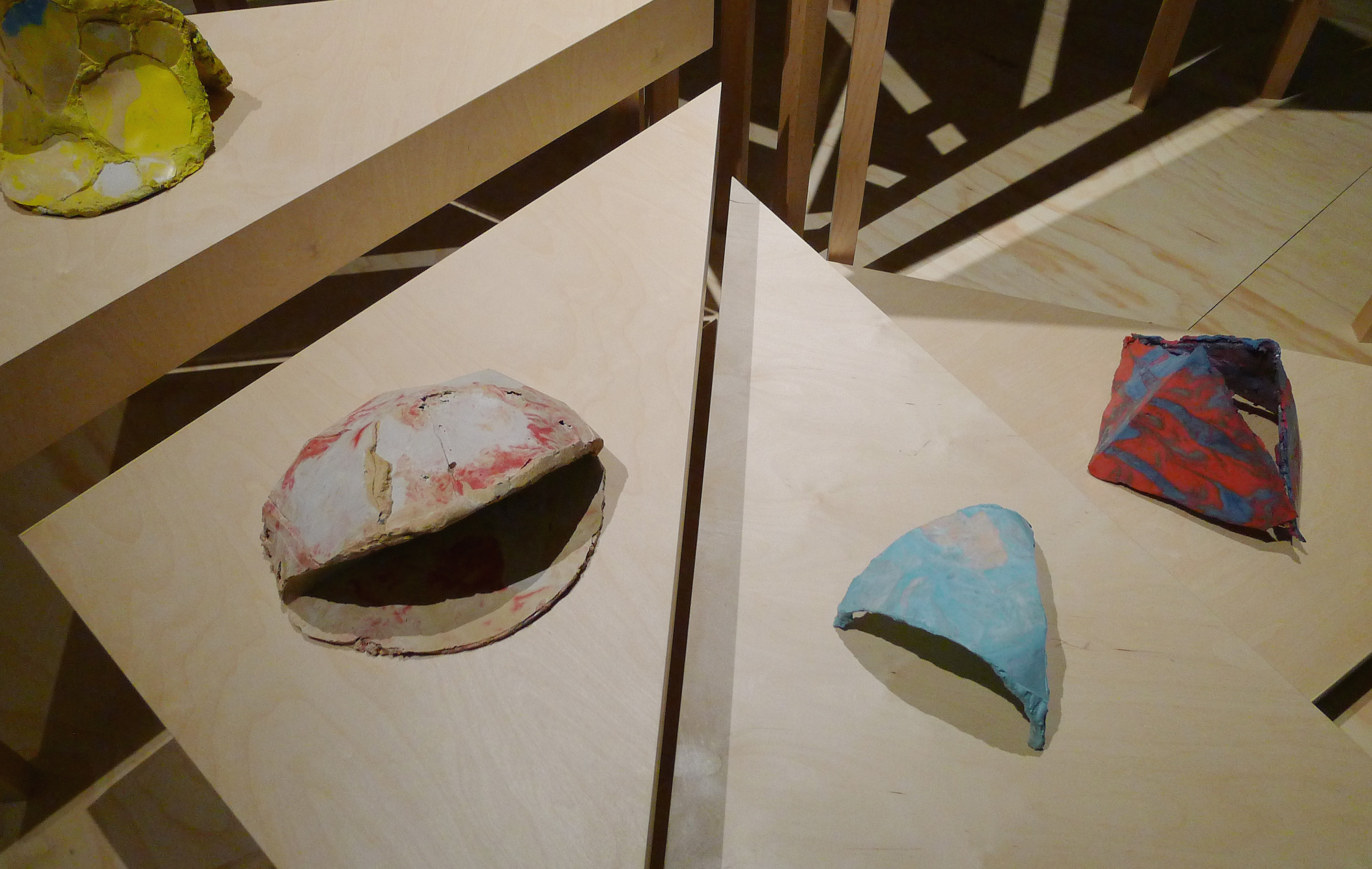
Detail: Mathematical distortions (nos. 1, 6, 7, 8, 9, 10, 12, 15, 17), 2012
Plaster, pigments, rabbit glue, and aluminum
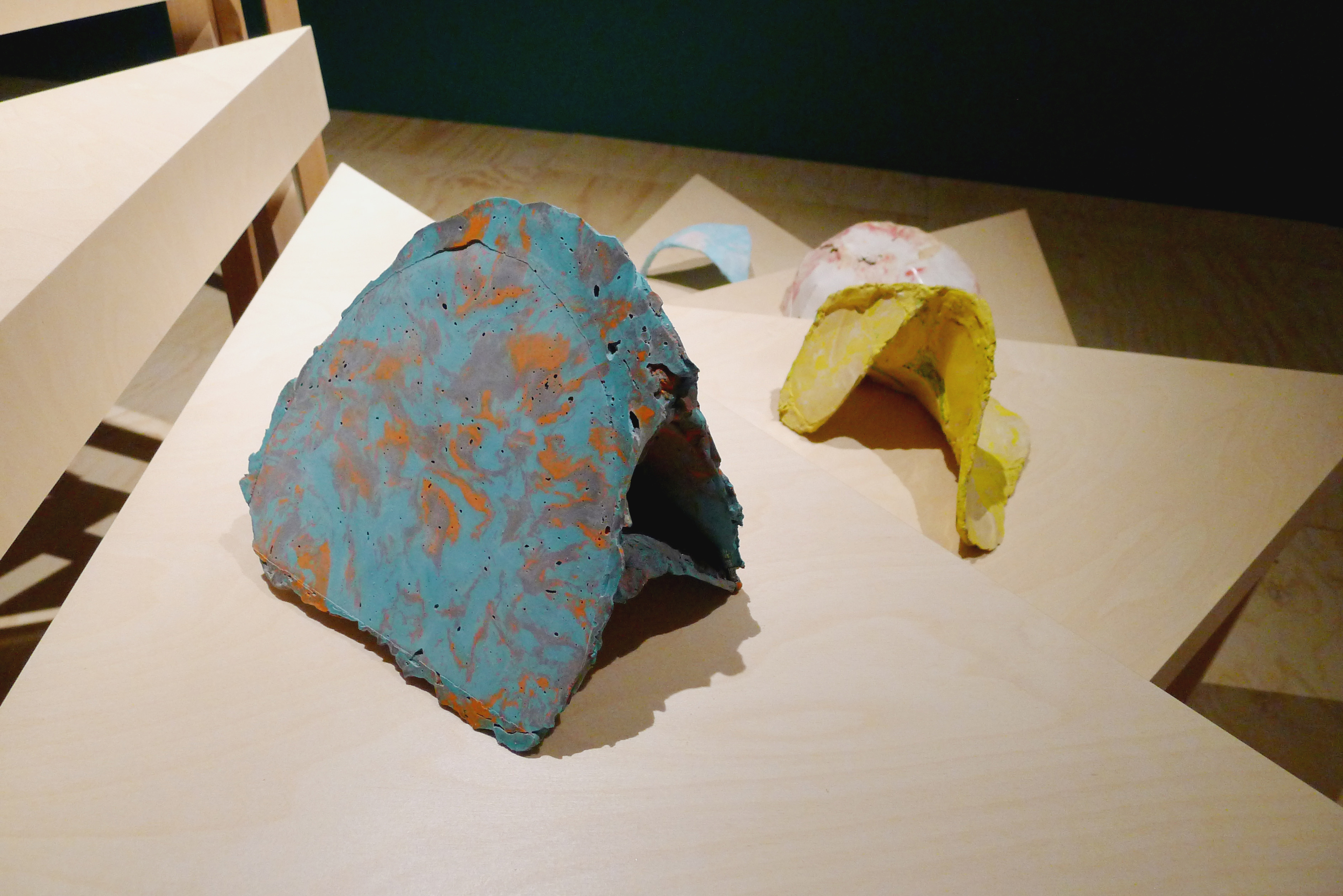
Detail: Mathematical distortions (nos. 1, 6, 7, 8, 9, 10, 12, 15, 17), 2012
Plaster, pigments, rabbit glue, and aluminum
Mathematical Distortions, part of a larger series Uncomfortable Objects (2012), point to how certain ambiguities within topology, a branch of mathematics, might serve as constructive metaphors for other fields of study and thought. The works on view originated with the artist’s interest in the topological models of mathematician Felix Klein (1849–1925) housed in the collection of the University of Göttingen in Germany. Klein is remembered today for the Klein bottle, a four-dimensional surface that is non-orientable and has no boundaries—that is, no outside or inside. Klein, however, also constructed a series of models of other surfaces, giving form to abstract and complex ideas about geometry and space with modest means like plaster, wire, wood, metal, and paper.
The shapes of the works—themselves “distortions”—describe their departure from Klein’s models as well as the nearly impossible task both Castillo Deball and Klein share in seeking to represent topological surfaces defined by mathematical equations. Made using scagliola, a marble imitation technique that involves a special composite of plaster, rabbit glue, and natural pigments, the forms of the Mathematical Distortions, like those of Klein’s models, reflect the limitations of matter by representing surfaces that do not exist—and in some cases, shapes that, like the Klein bottle, have no outside or inside. In the context of the exhibition, these objects speak to the potential of thinking across disciplines—and across dimensions of space—to reexamine notions of orientation and boundaries and how their theoretical absence could altogether undermine the validity and scope of our knowledge.
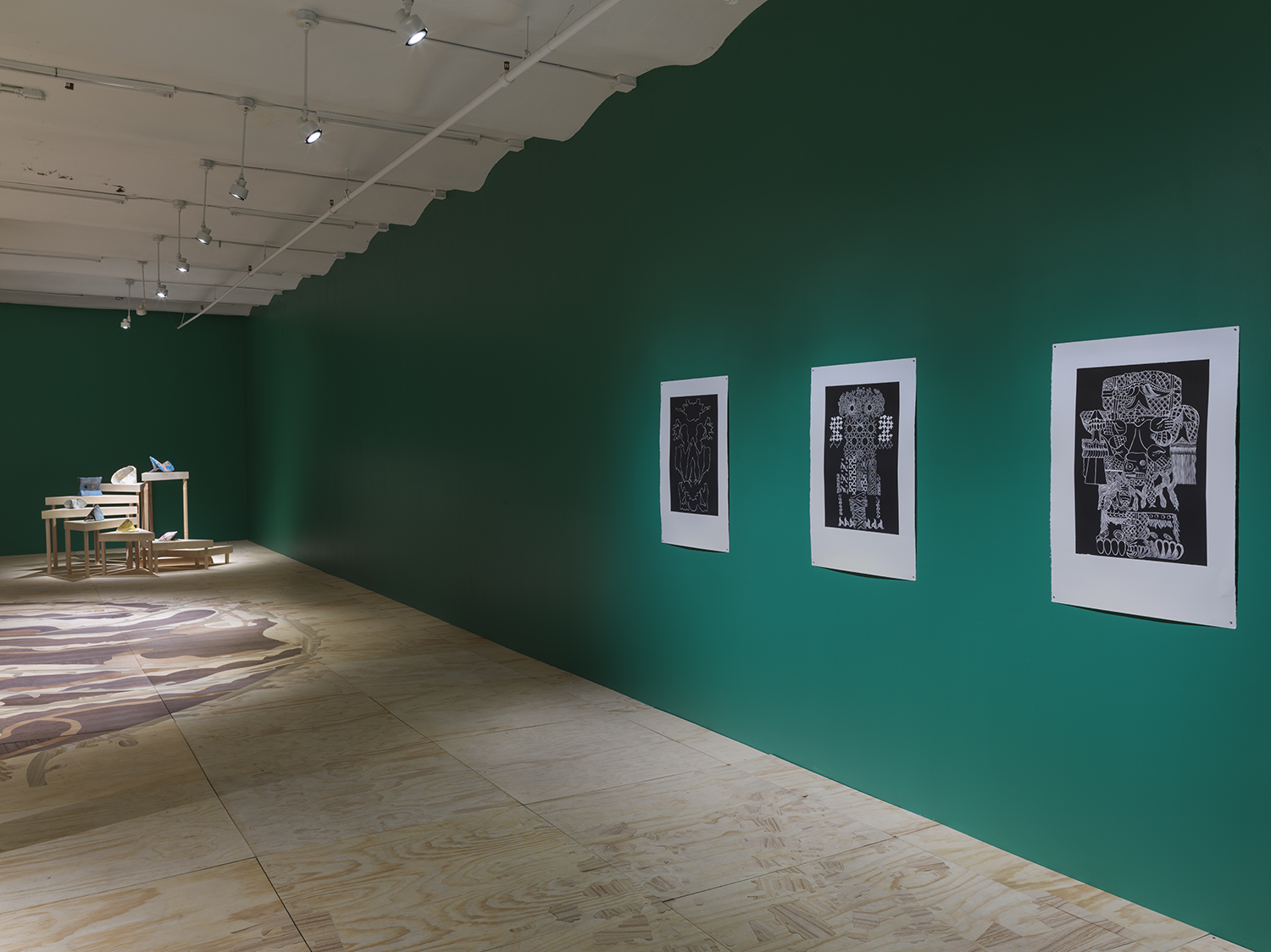
Installation view Finding Oneself Outside, New Museum, New York, USA, 2019
. Photo: Maris Hutchinson / EPW Studio.
Vista de Ojos
kurimanzutto, Mexico City July 1 – September 6, 2014

Detail: Vista de Ojos, 2014
Set of 130. 18 mm. plywood plate incised with CNC router
The centerpiece of the exhibit, Vista de Ojos (2014), is a wooden pavement engraved with the drawing of the Santa Cruz map (1550).
The original drawing was created by an indigenous cartographer or Tlacuilo, and is considered to be the oldest with such a detailed and reliable representation of Mexico City some thirty years after the conquest. The center of the image shows the expansion of the European layout of the city with the buildings lined up along straight streets. The houses belonging to the conquerors and the first settler’s, shaped as European buildings, compose a series of uniform city blocks. On the outskirts one can see the indigenous settlements and their inhabitants engaging in everyday activities.
The multiple symbols on the map (heads, animals, stars, rings, etc.) represent the names of places in Nahuatl, and depicts the capital’s social life and everyday activities, as well as the geography, flora, and fauna of Mexico City during this period. Presently, the original map is located in Upsala, Sweden, although the exact circumstances of its acquisition remain unknown. The only existing theory is that it was bought by Swedish linguist and traveller, Johan Gabriel Sparwenfeld, in the late seventeenth century during his stay in Spain and was later donated to the library of the Uppsala University.

Uppsala map of Tenochtitlan, around 1521
1 map, 75 x 144 centimeters, hand-painting on two joined pieces of parchment (read more)

Atlas. Vista de Ojos, 2014
Xylographic print on 34 g. Zairei japanesse paper. Photo: Estudio Michel Zabé
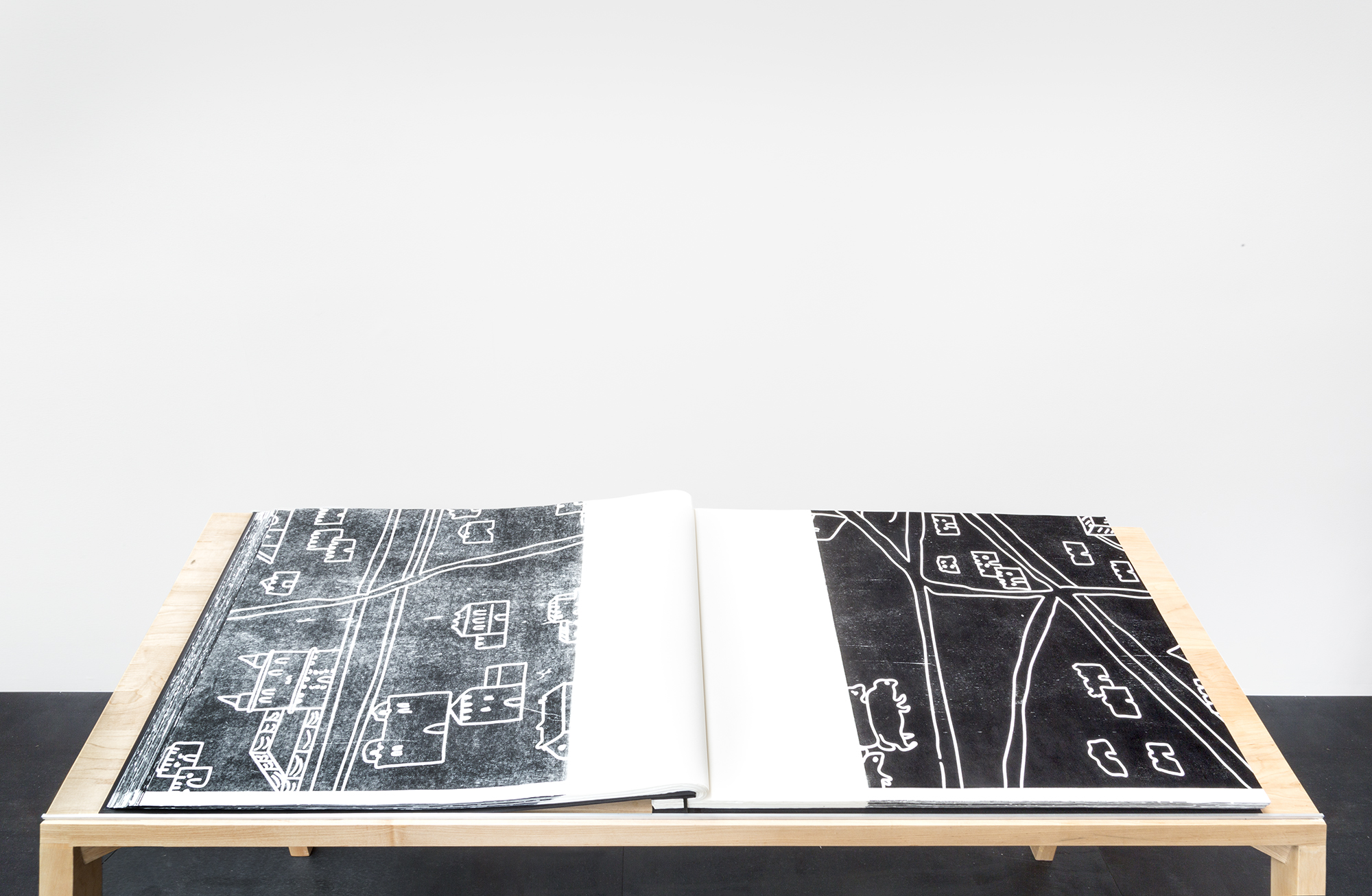
Atlas. Vista de Ojos, 2014
Xylographic print on 34 g. Zairei japanesse paper.
Photo: Estudio Michel Zabé
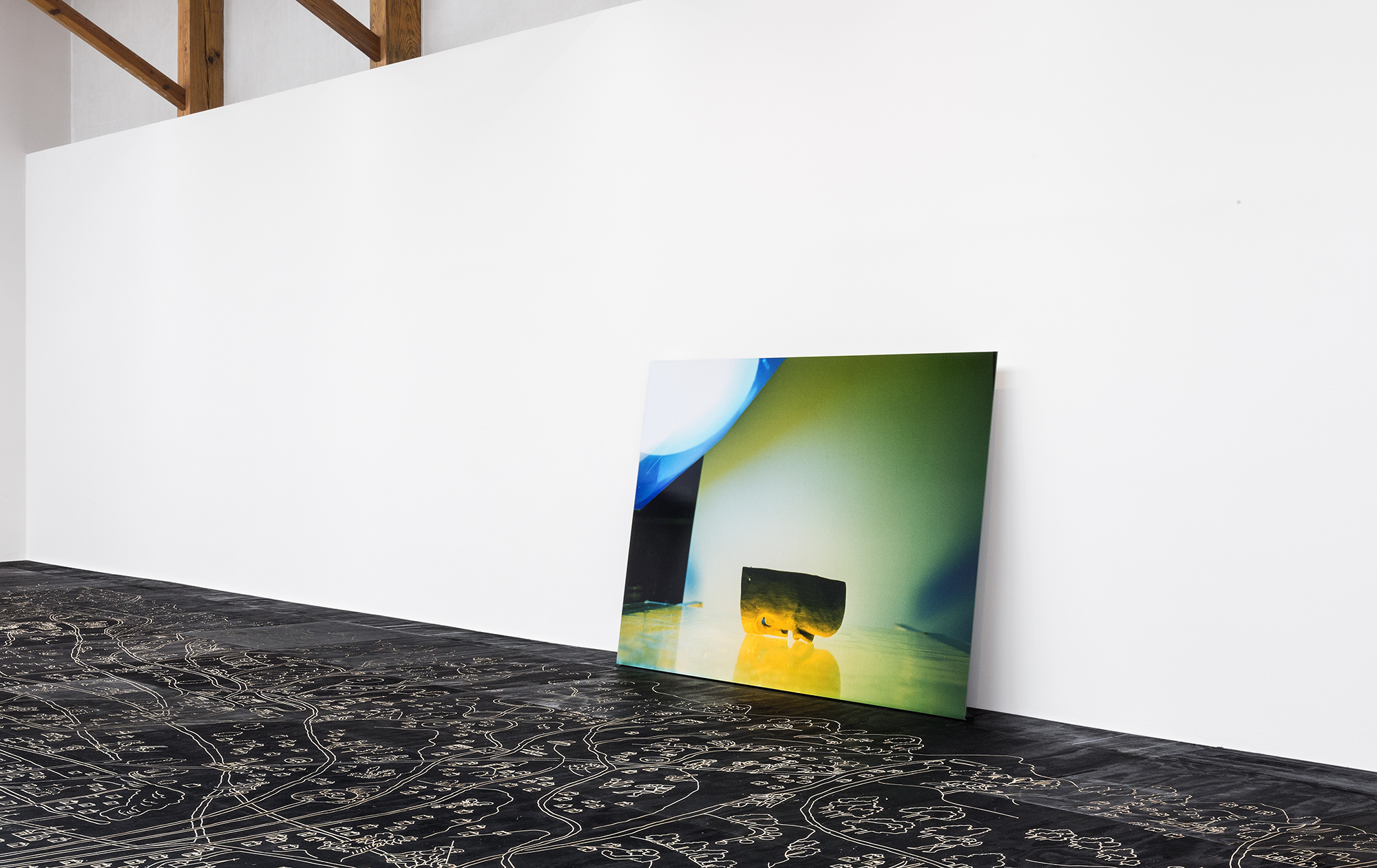
Untitled, 2014
Laserchrome print mounted on dibond.
Photo: Estudio Michel Zabé
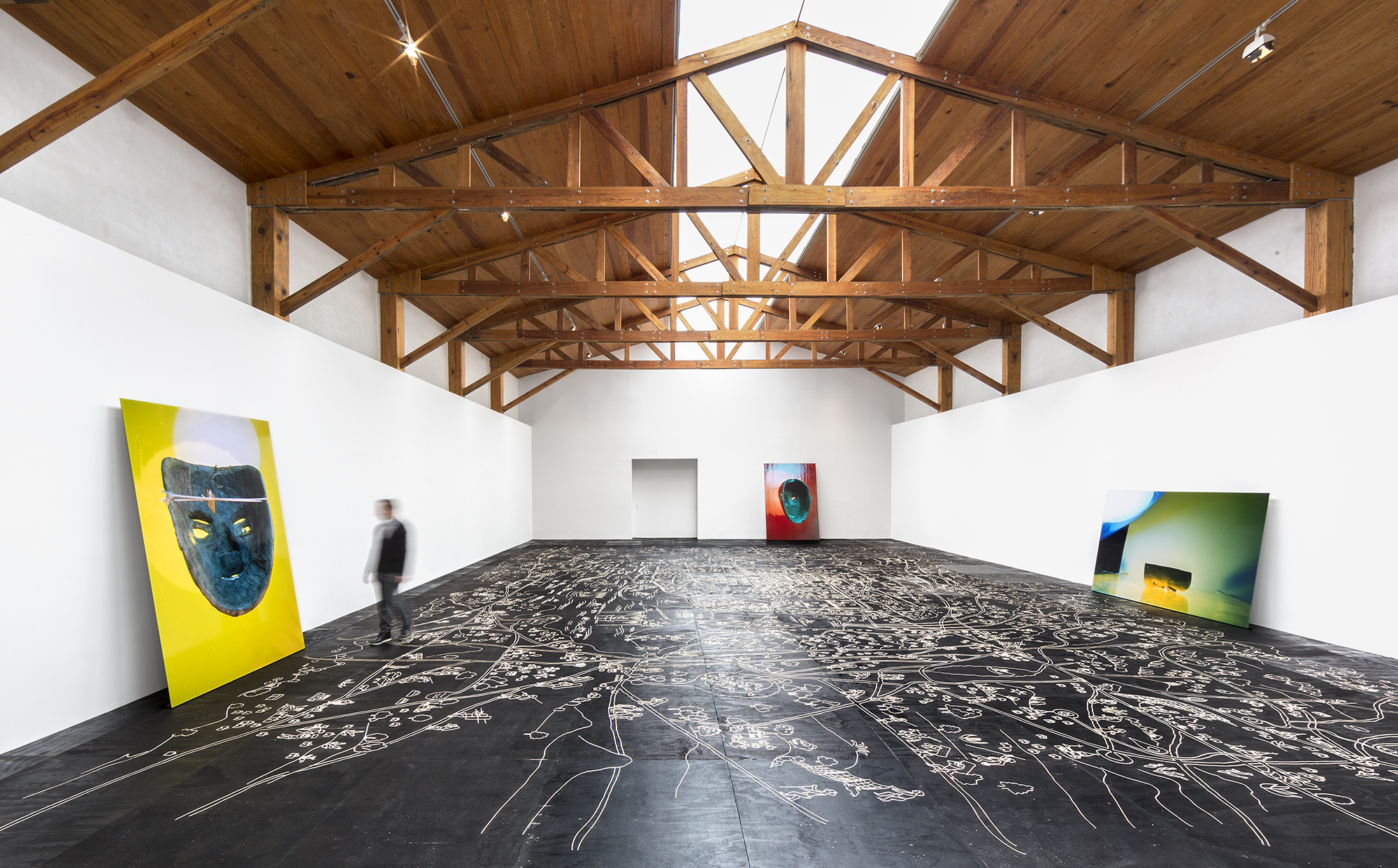
Vista de Ojos, 2014
Set of 130. 18 mm. plywood plate incised with CNC router.
Photo: Estudio Michel Zabé
The wooden pavement also serves as a printing matrix. The complete surface of the map was printed on paper and bound as an atlas, each of the 500 pages, corresponding to a fragment of the image.
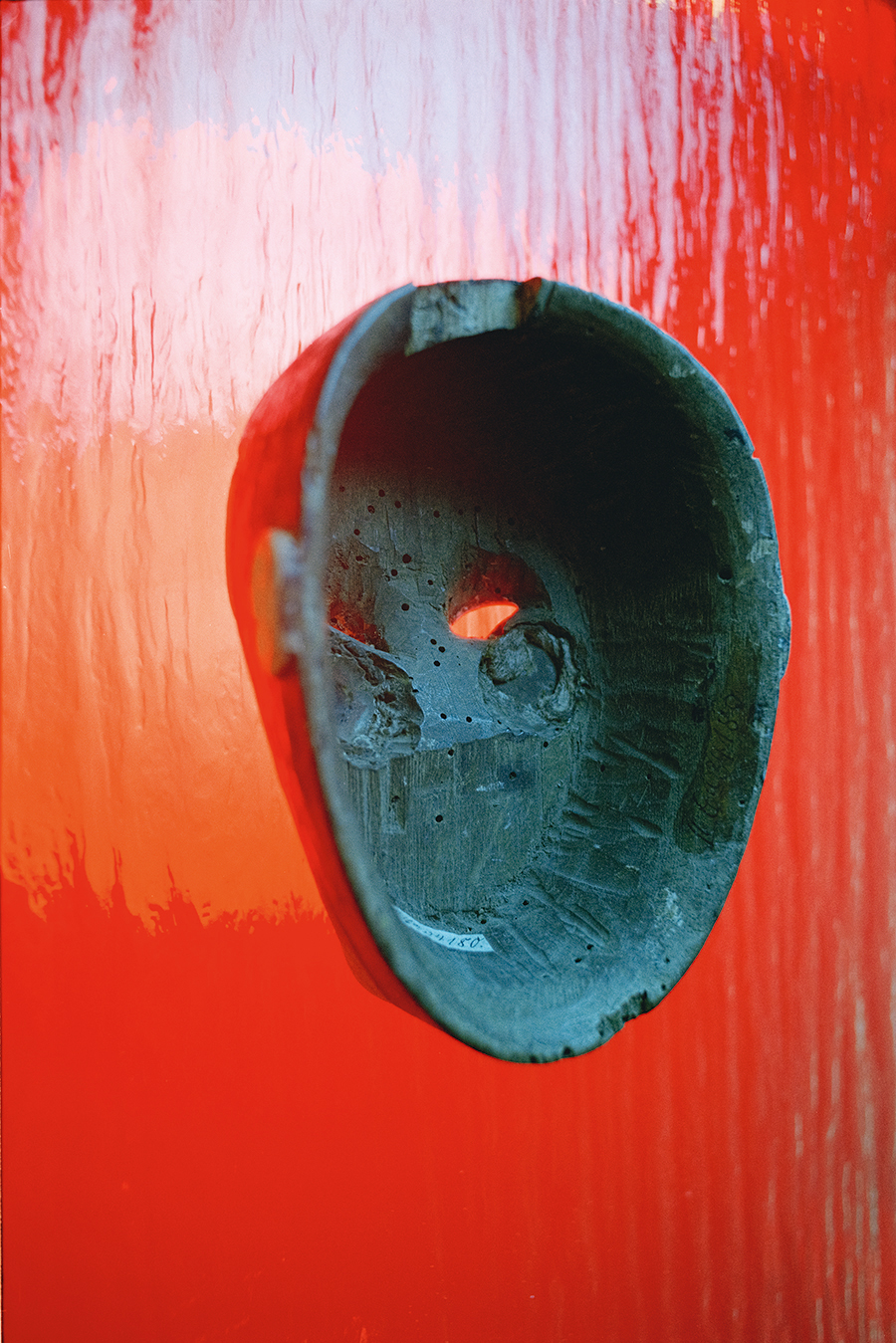
Untitled, 2013
Laserchrome print mounted on dibond
The series of large-format photographs UMRISS (2014) departs from a Mexican advertisement of the 80’s promoting Stelazine, an antipsychotic medicine. The flyer used the following slogan:
Schizophrenic patients sometimes hide behind a mask of psychotic withdrawal, which can make them inaccessible to therapy.
Stelazine
Remove the mask of the psychotic patient.
This pamphlet was illustrated with images of Mexican masks with extravagant and texturized color backgrounds, which was in turn a translation of the American advertisement for the same brand.
Mimicking the style of the promotional folder, UMRISS (2014) is a series of photographs from the Mesoamerican collection of the Ethnographic Museum in Berlin; acquired at the beginning of the twentieth century and originating primarily from the south of Mexico and Guatemala. The photographs in the exhibition depart from the original ones in that they only show the backside of the masks.
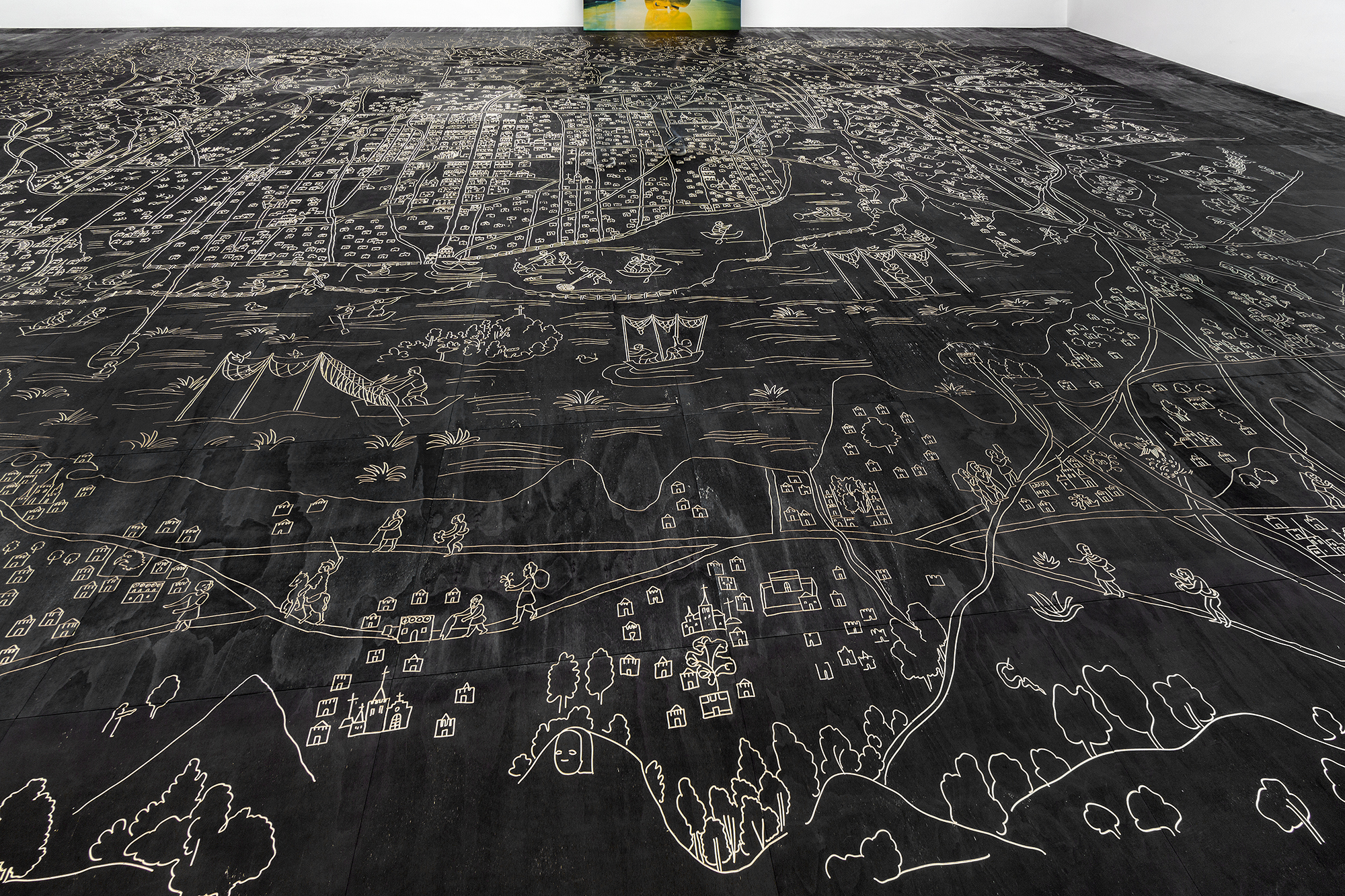
Detail: Vista de Ojos, 2014
Set of 130. 18 mm. plywood plate incised with CNC router.
Photo: Estudio Michel Zabé

Detail: Vista de Ojos, 2014
Set of 130. 18 mm. plywood plate incised with CNC router

Detail: Vista de Ojos, 2014
Set of 130. 18 mm. plywood plate incised with CNC router
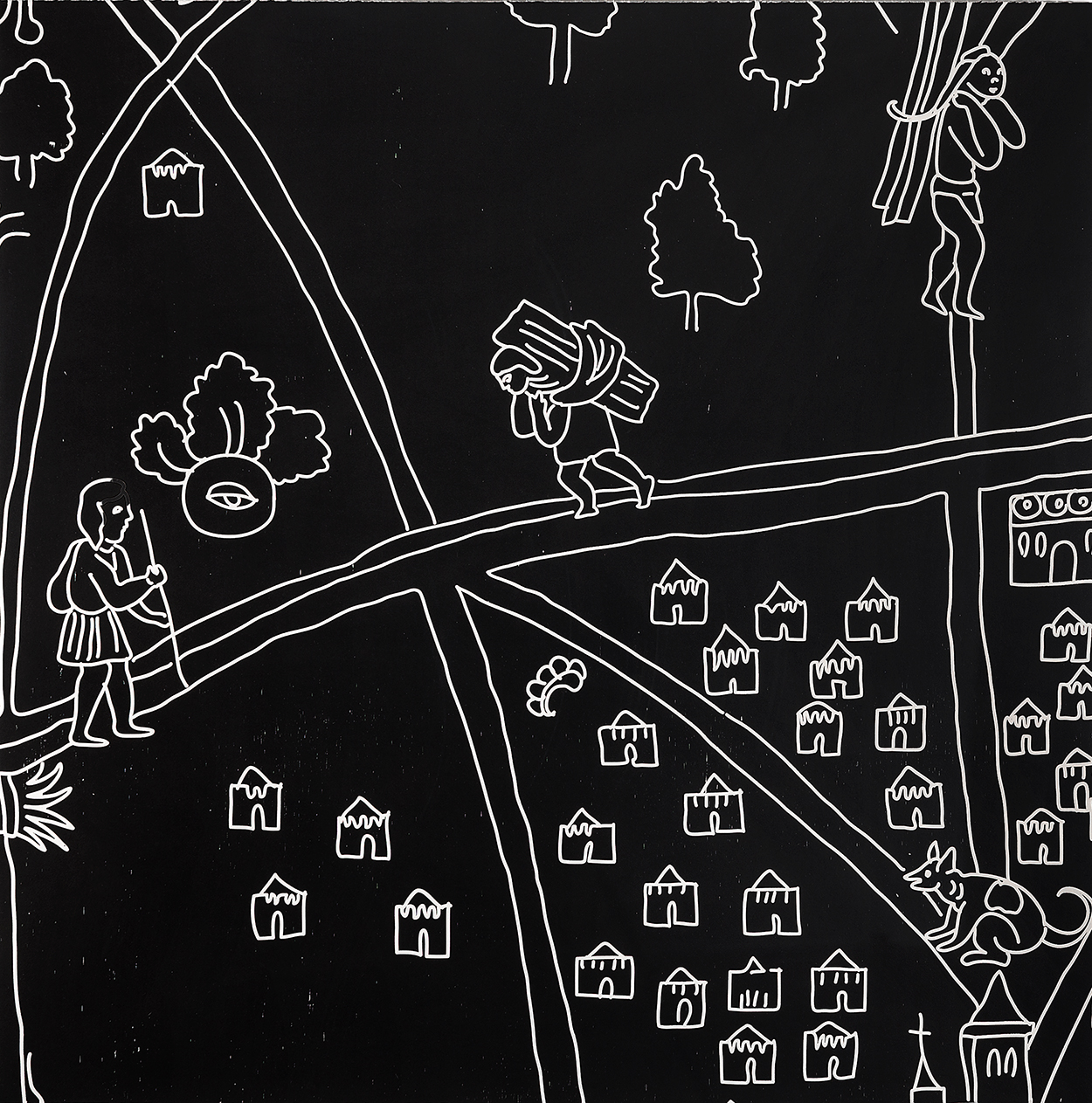
Vista de Ojos no. 43, 2013
Xylographic print on paper
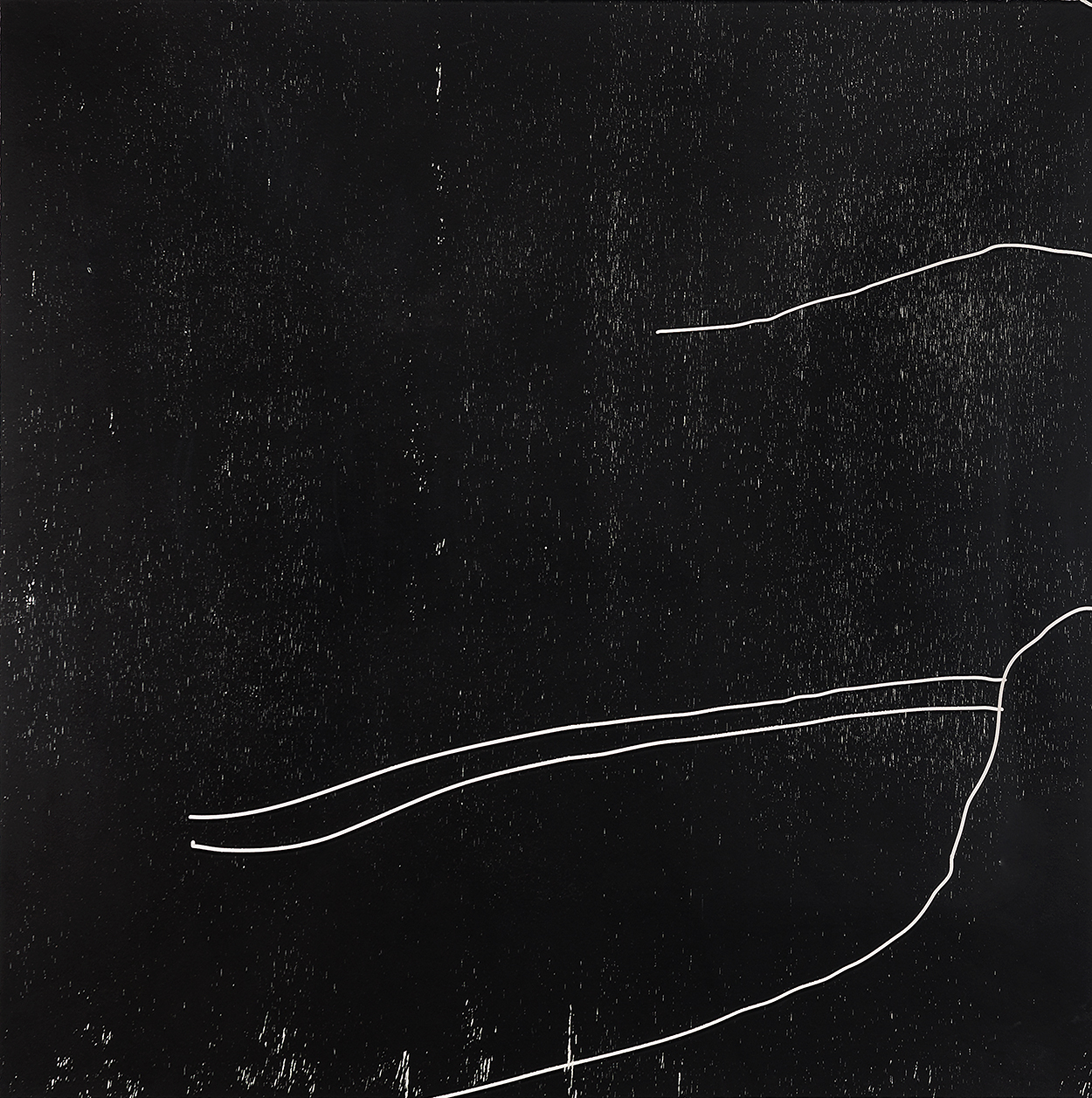
Vista de Ojos no. 91, 2013
Xylographic print on paper
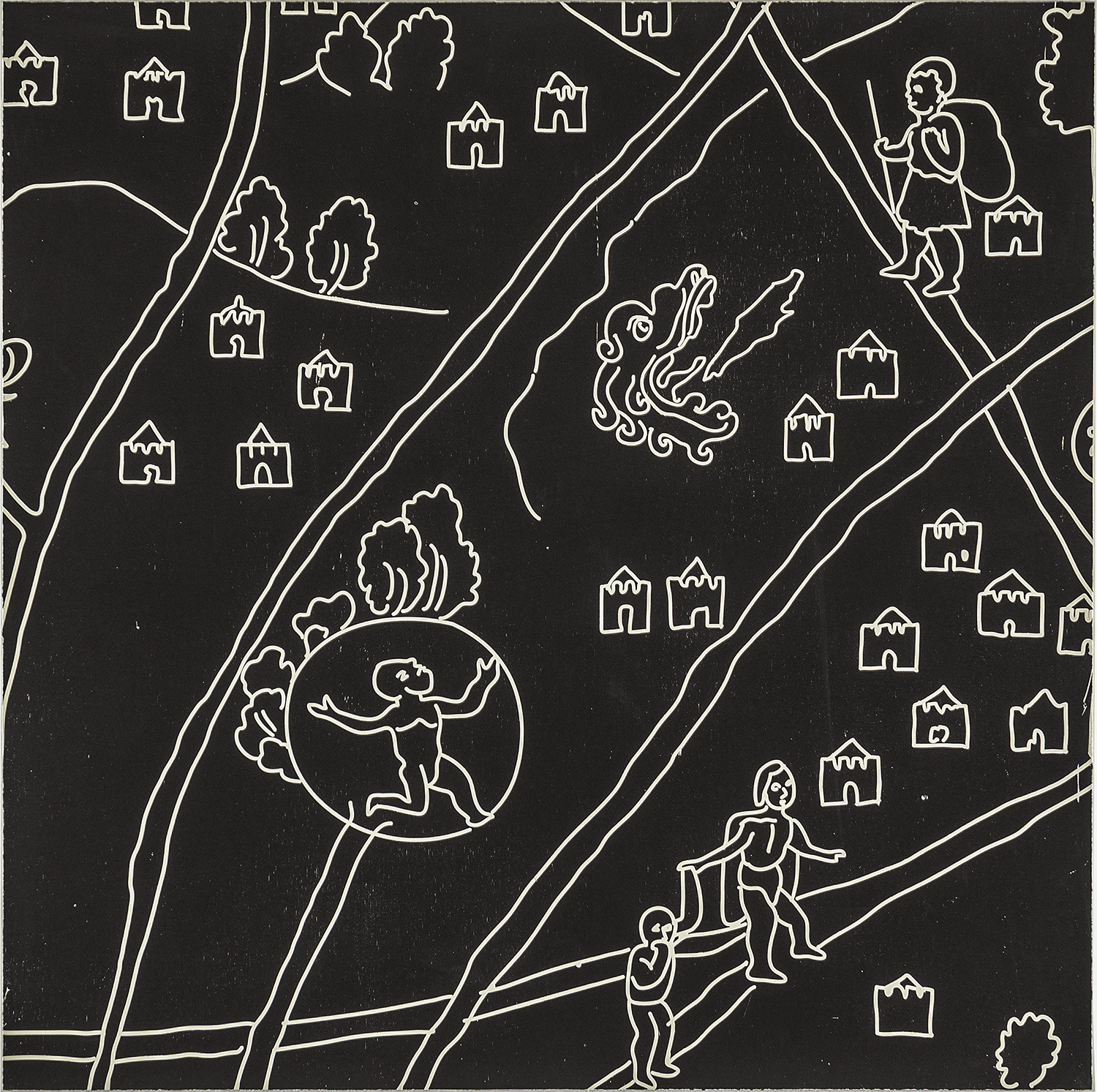
Vista de Ojos no. 35, 2014
Xylographic print on paper
My flowers will not end,
My singing will not end,
they are shared, they are scattered.
Even when the flowers
wither and become yellow,
they will be taken there,
inside the home
of the bird with golden feather,
Preis der Nationalgalerie für junge Kunst Museum Hamburger bahnhof, Berlin, 2013
August 30 – January 01, 2014
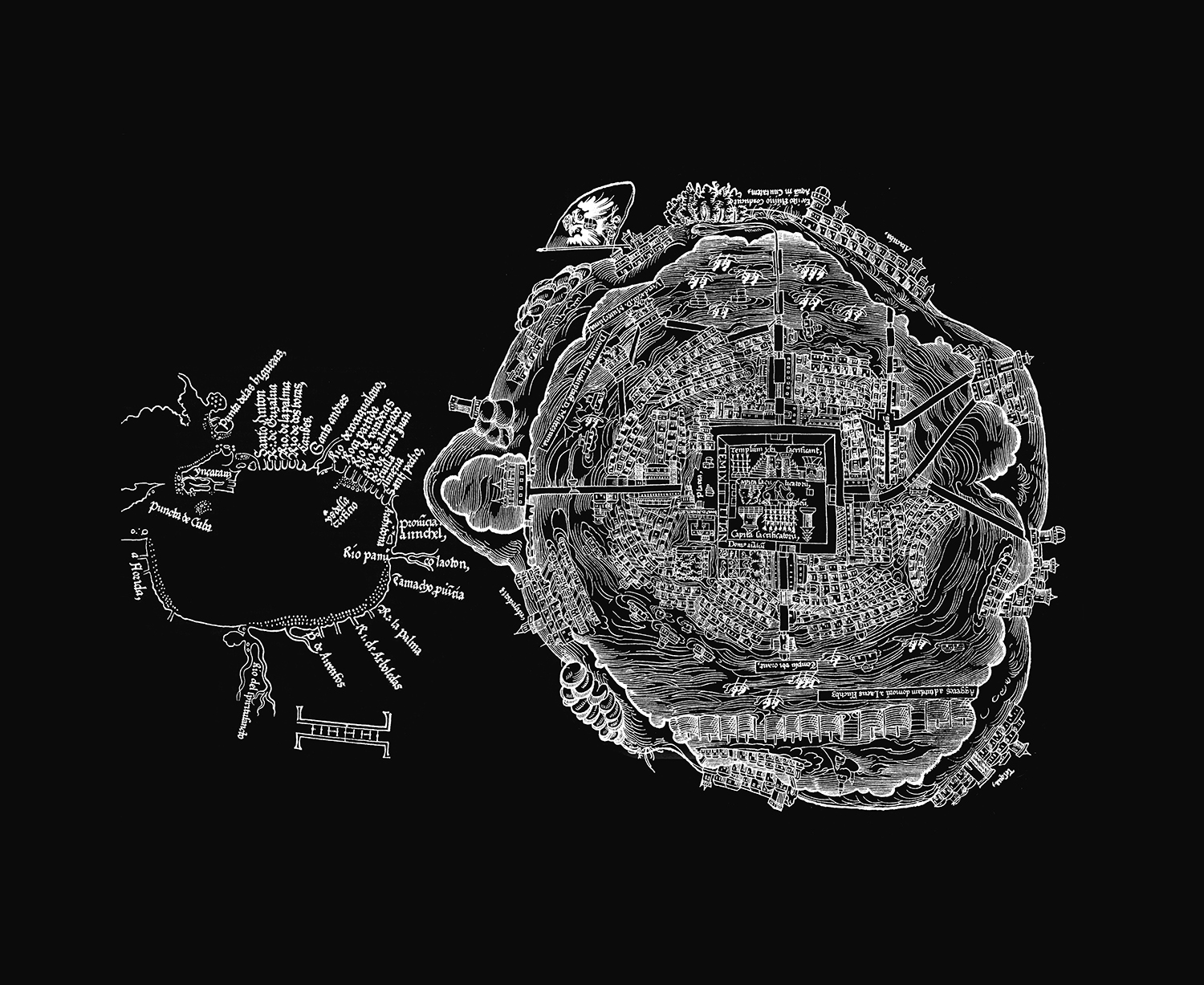
Woodcut carved with CNC router of the Nuremberg map of Tenochtitlán, (1524)
The exhibition space at the Hamburger Bahnhof is paved entirely in wood, engraved with the image of the Nuremberg map of Tenochtitlan. The wooden surface is also used as a matrix from which a one-to-one print of the engraved surface is made onto paper. The Atlas, a bound volume of the prints, is also shown in the exhibition.
Elements from Chinelo costumes seem to float in the space: a hat, a mask, some costumes, and decorative elements.
In 1521, a letter and two maps arrived in Spain for the Spanish king Charles V. This was the second of five letters that the conquistador Hernán Cortés sent describing the Aztec capital Tenochtitlan. One map was a detailed illustration of the city, and the other a sketch of the nearby Gulf of Mexico coast. This depiction of Tenochtitlan served to justify the expensive Spanish colonial efforts. The publication in Nuremberg of the map in 1524, along with the letter’s translation into Latin, sparked the imagination and support of a large European audience. This map was the first and the most widespread image that Europeans had of Tenochtitlan.
The published map resulted from many copies made on the way from Mexico, through Spain, to Nuremberg, and the original map probably was drawn by an indigenous artist. The portrayal of rows of houses and the depiction of the island capital in the center of a circular lake is not only to be found in the European mapping tradition, but also in the Aztec one. The map also contains details that were not mentioned in Cortés’s letters, such as Aztec historical and religious references, which were not understood by Europeans at the time.

Nuremberg Map of Tenochtitlan, 2013
CNC engraved wooden floor,costumes, embroideries, masks
Preis der Nationalgalerie für Junge Kunst, Hamburger Bahnhof – Museum für Gegenwart, Berlin, 2013.
Photo: David von Becker.
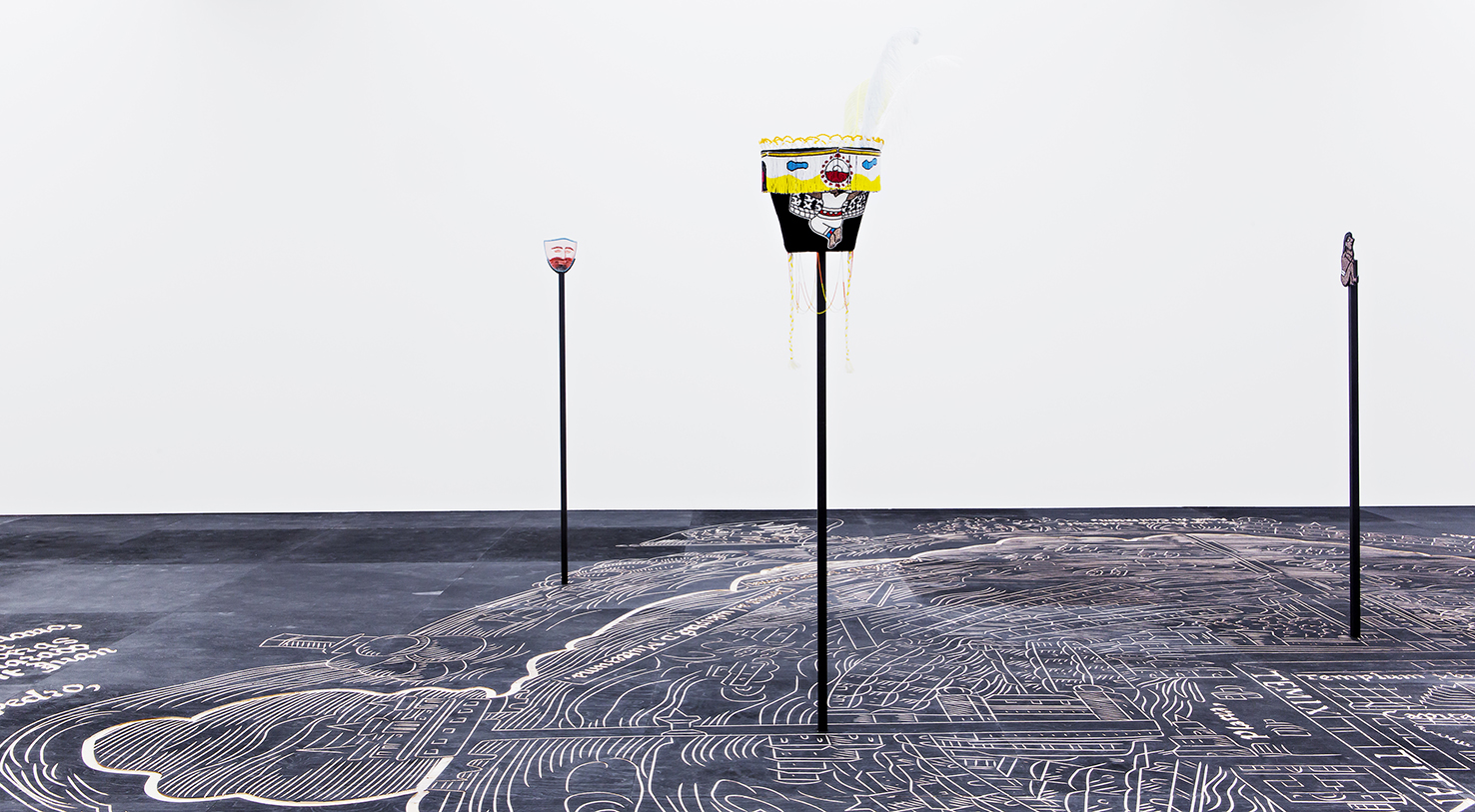
Nuremberg Map of Tenochtitlan, 2013
CNC engraved wooden floor,costumes, embroideries, masks.
Photo: David von Becker.

Nuremberg Map of Tenochtitlan, 2013
CNC engraved wooden floor,costumes, embroideries, masks.
Photo: David von Becker.

Detail: Nuremberg Map of Tenochtitlan, 2013
CNC engraved wooden floor,costumes, embroideries, masks.
Photo: David von Becker.
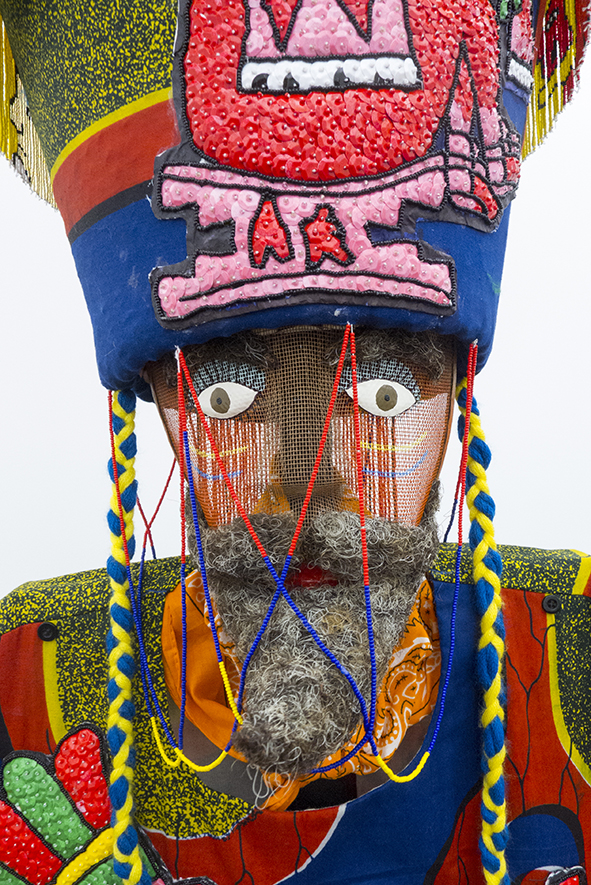
Detail: Nuremberg Map of Tenochtitlan, 2013
CNC engraved wooden floor,costumes, embroideries, masks.
Photo: David von Becker.
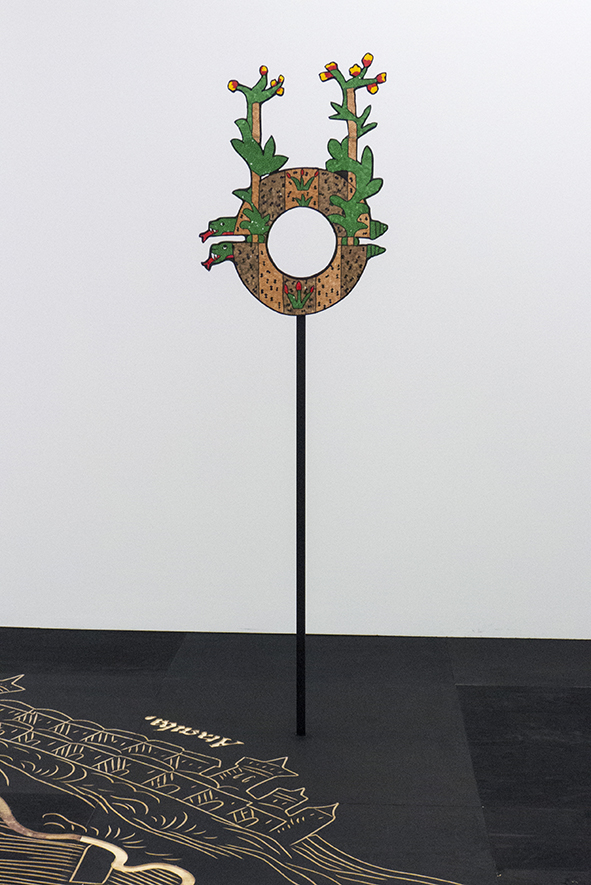
Detail: Nuremberg Map of Tenochtitlan, 2013
CNC engraved wooden floor,costumes, embroideries, masks.
Photo: David von Becker.
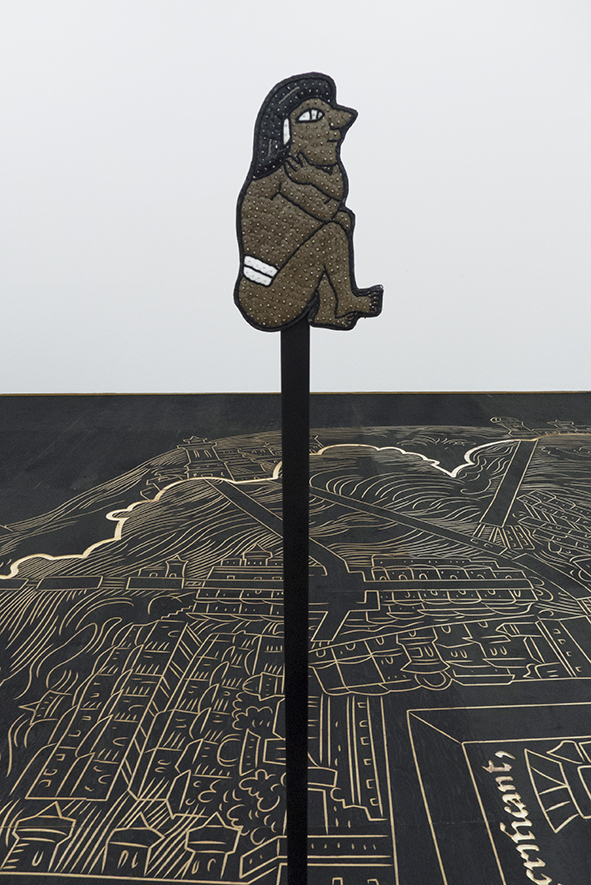
Detail: <Nuremberg Map of Tenochtitlan, 2013
CNC engraved wooden floor,costumes, embroideries, masks.
Photo: David von Becker.
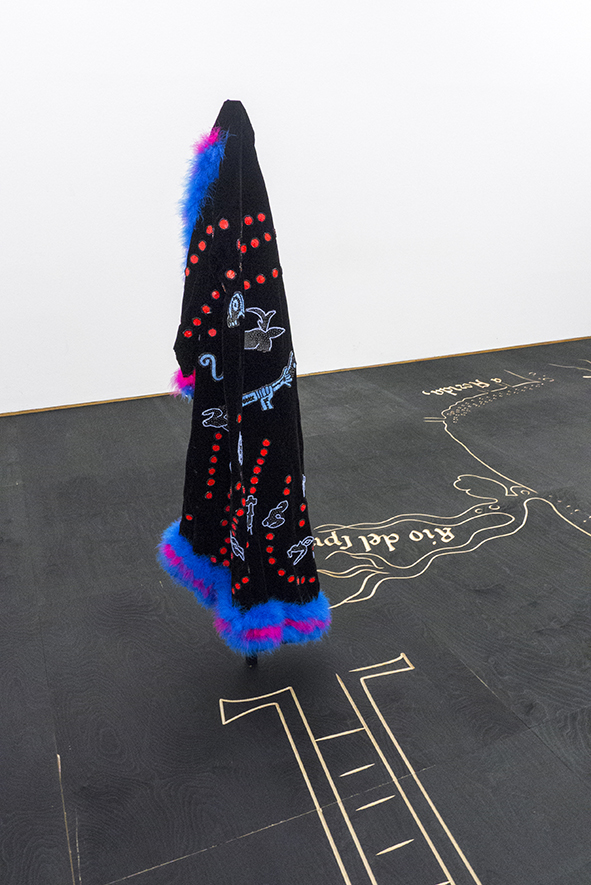
Detail: Nuremberg Map of Tenochtitlan, 2013
CNC engraved wooden floor,costumes, embroideries, masks.
Photo: David von Becker.
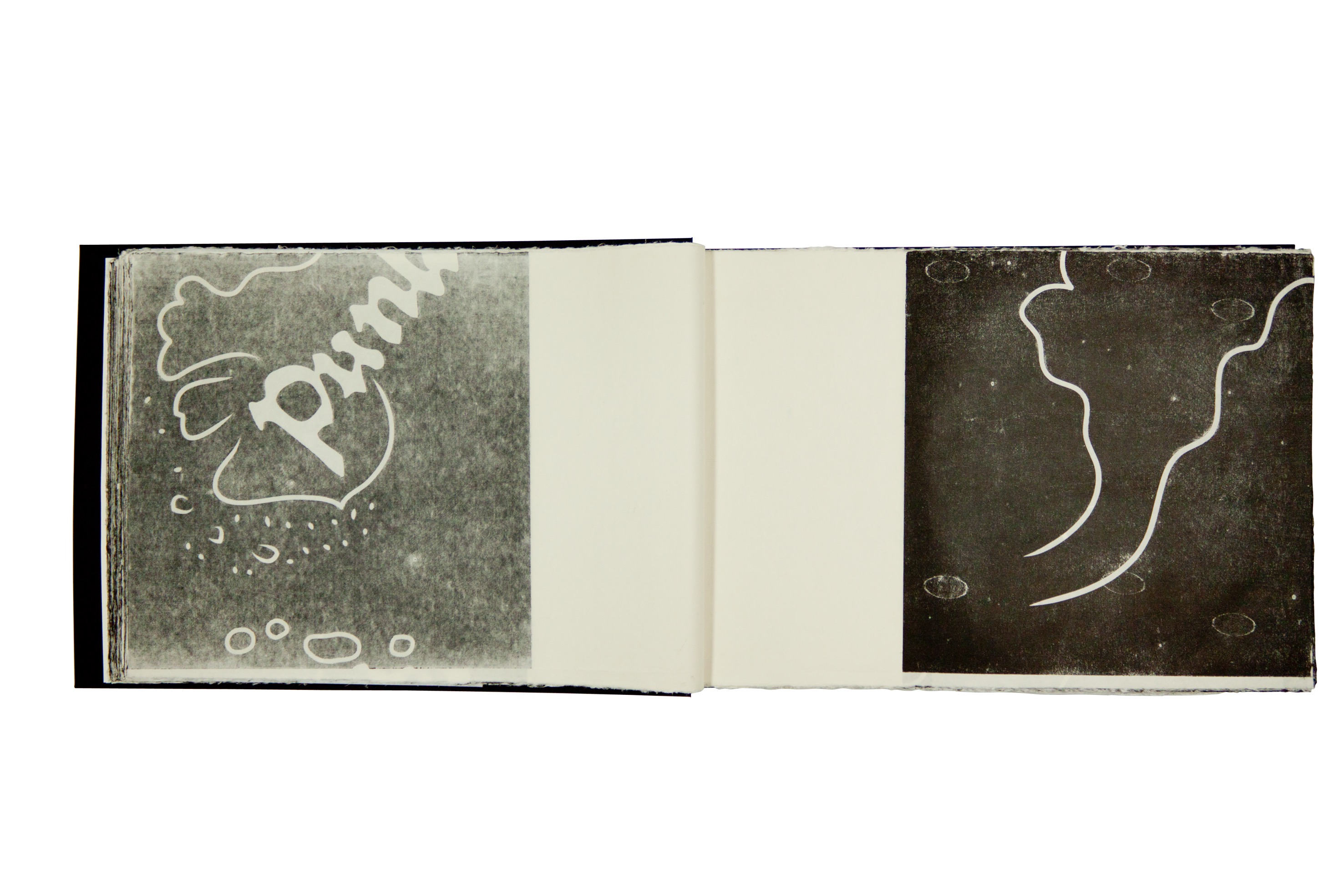
Atlas, Nuremberg Map of Tenochtitlan, 2013
book bound woodcut prints
Hosokawa paper 39g,
450 paper sheets
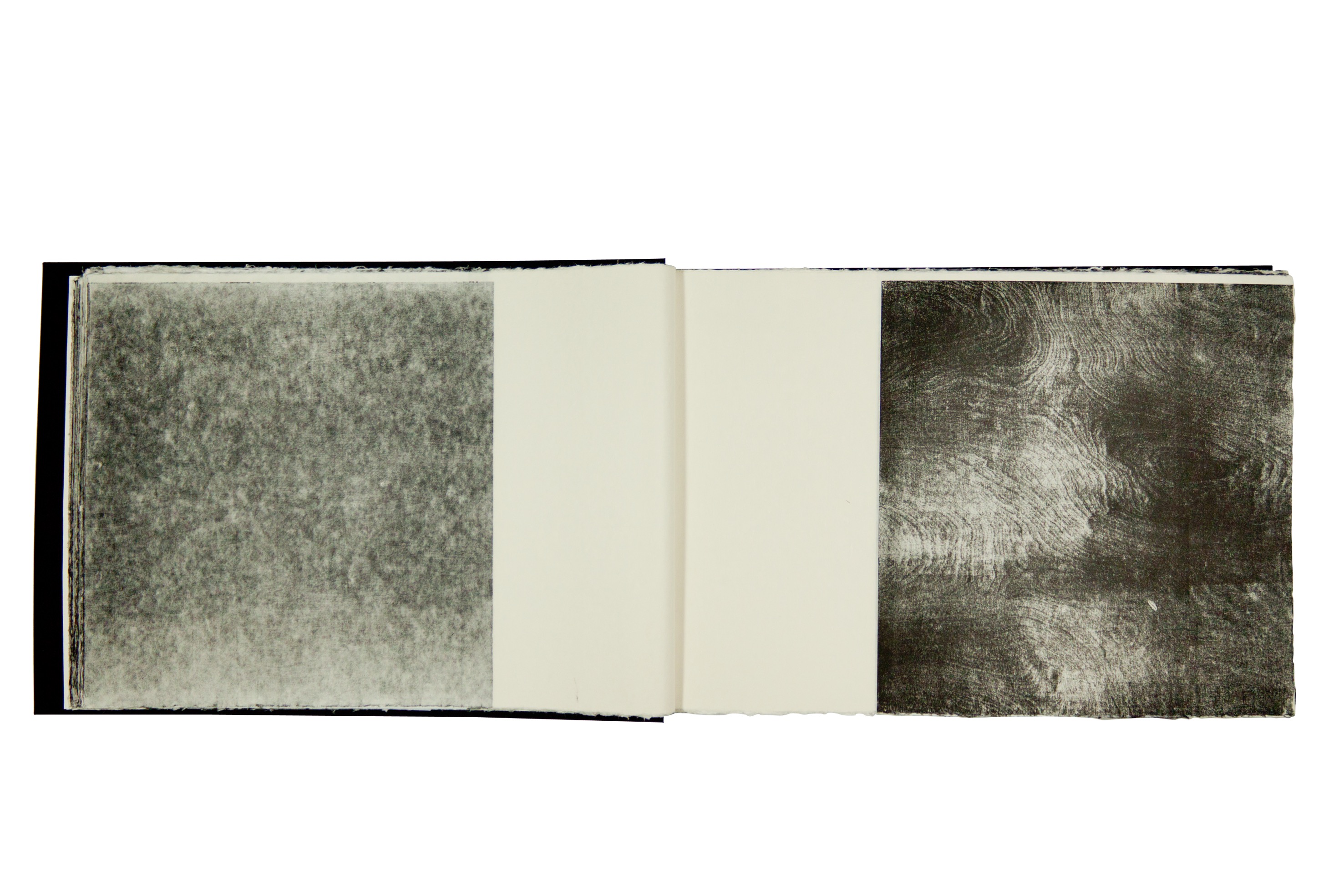
Atlas, Nuremberg Map of Tenochtitlan, 2013
book bound woodcut prints
Hosokawa paper 39g,
450 paper sheets
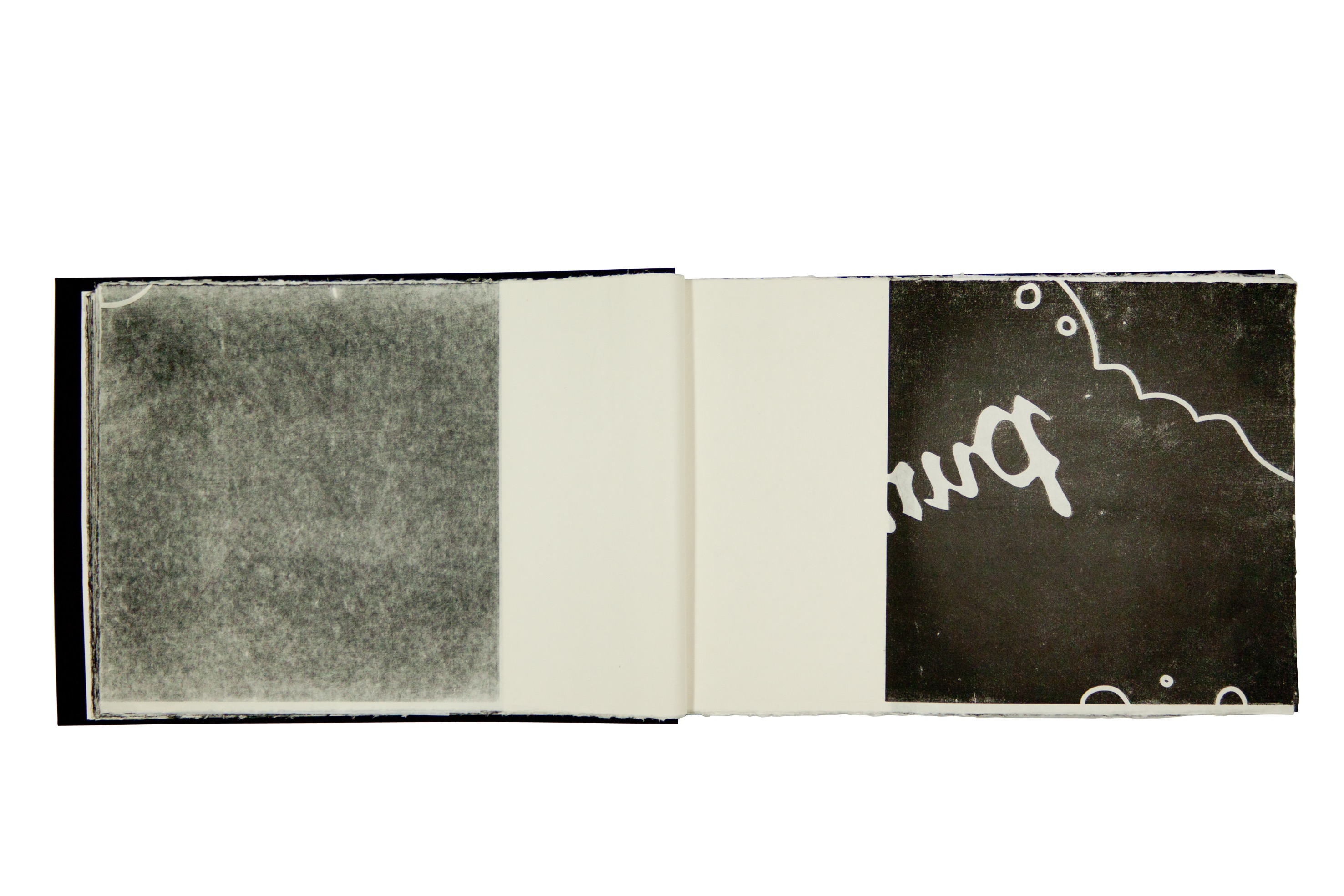
Atlas, Nuremberg Map of Tenochtitlan, 2013
book bound woodcut prints
Hosokawa paper 39g,
450 paper sheets
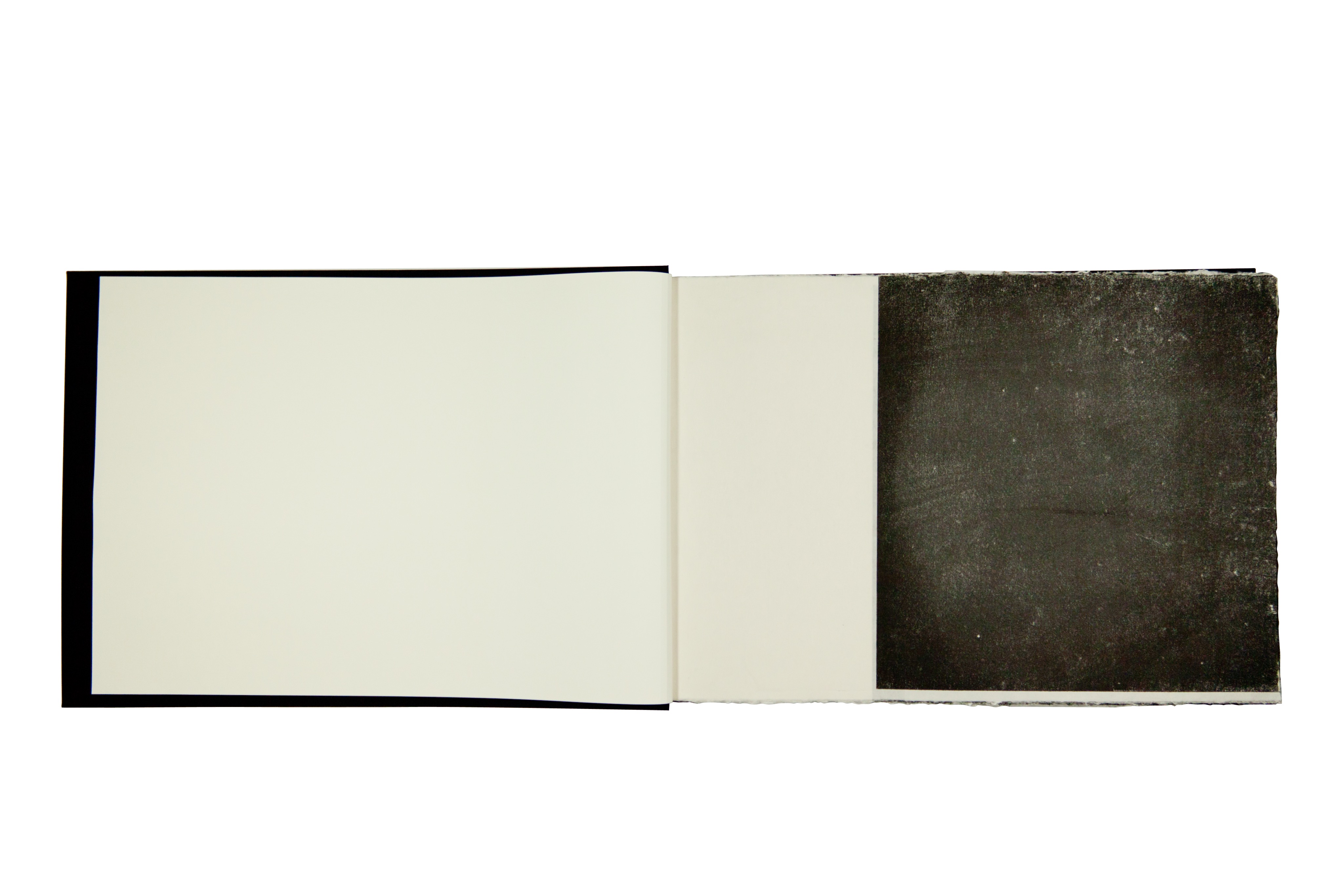
Atlas, Nuremberg Map of Tenochtitlan, 2013
book bound woodcut prints
Hosokawa paper 39g,
450 paper sheets

Atlas, Nuremberg Map of Tenochtitlan, 2013
book bound woodcut prints
Hosokawa paper 39g,
450 paper sheets

Atlas, Nuremberg Map of Tenochtitlan, 2013
book bound woodcut prints
Hosokawa paper 39g,
450 paper sheets
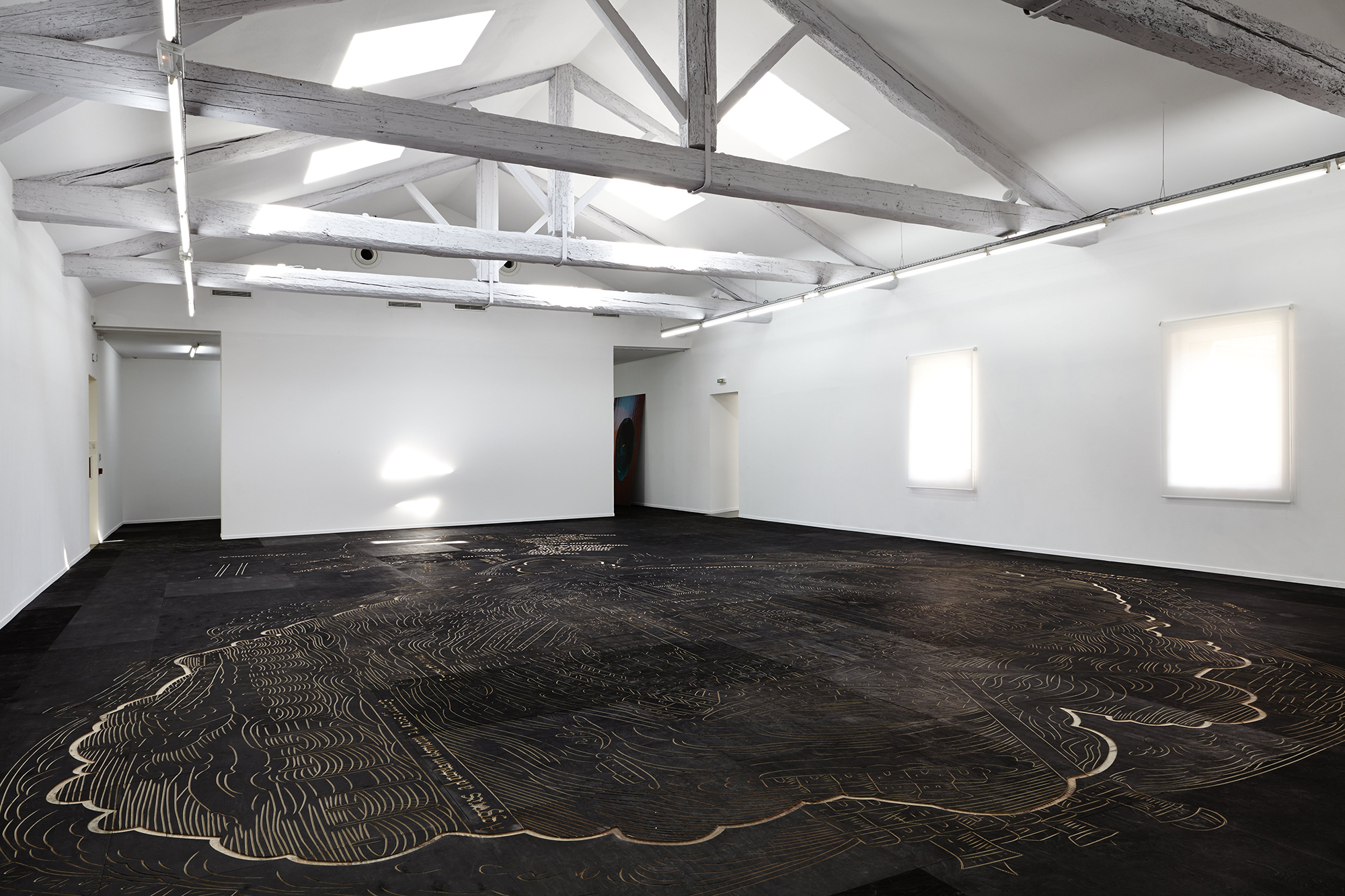
Nuremberg Map of Tenochtitlan, 2013
CNC engraved wooden floor, dimensions variables
Installation views of Cronotopo, CAPC Musée régional d’art contemporain, Sérignan, France, 2015.
Photos: Jean-Christophe Lett.
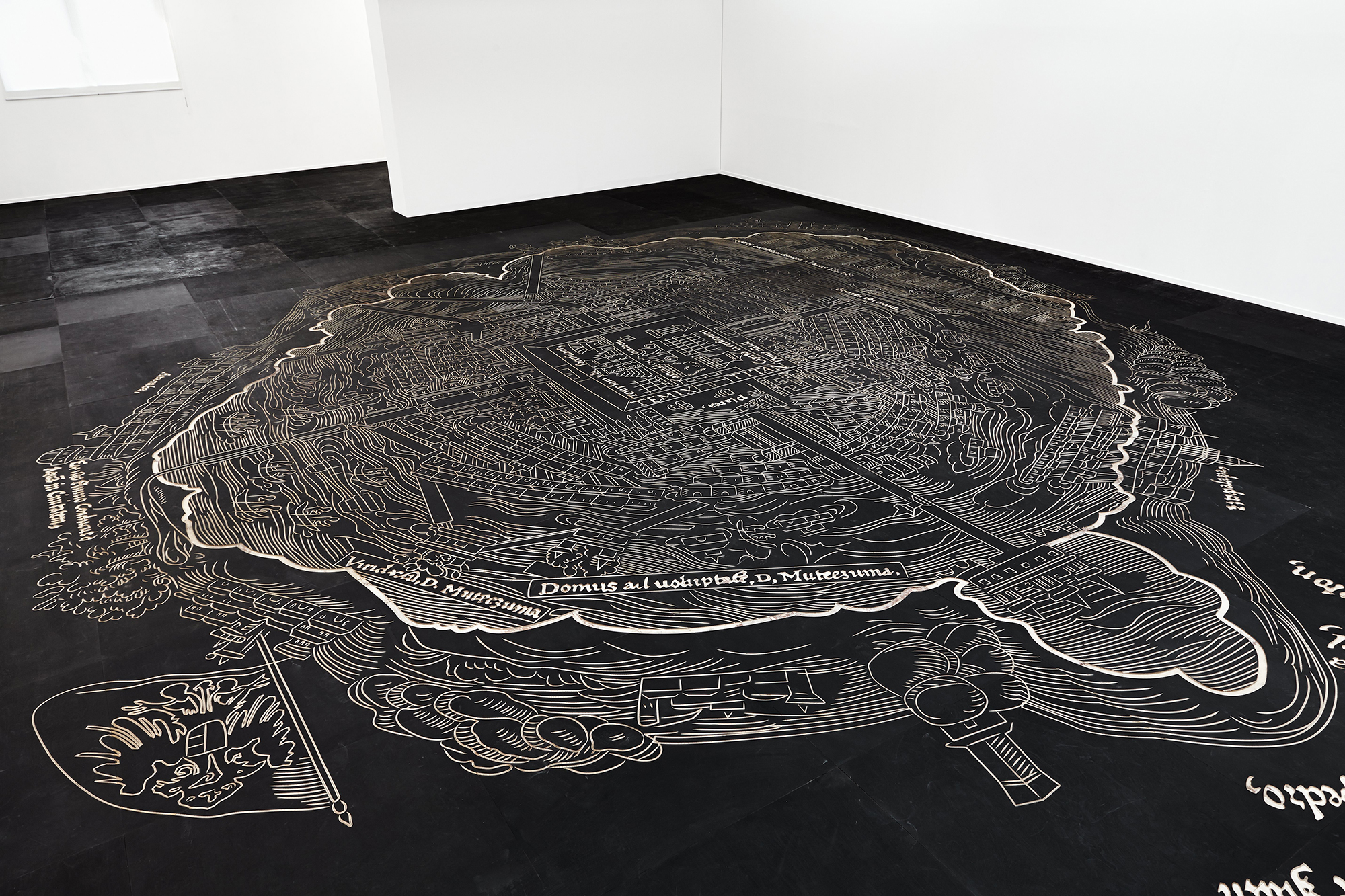
Nuremberg Map of Tenochtitlan, 2013
CNC engraved wooden floor, dimensions variables
Installation views of Cronotopo, CAPC Musée régional d’art contemporain, Sérignan, France, 2015.
Photos: Jean-Christophe Lett.

Nuremberg Map of Tenochtitlan, 2013
CNC engraved wooden floor, dimensions variables
Installation views of Cronotopo, CAPC Musée régional d’art contemporain, Sérignan, France, 2015.
Photos: Jean-Christophe Lett.
No acabarán mis flores Arqueológica, Matadero, Madrid January - May 9, 2013 Curated by Virginia Torrente
In colonial times, the Spaniards held splendid parties for Carnival, to which the indigenous and mestizo population was not invited. These segregated castes began to celebrate their own parties as satire, parodying the white people by donning pink masks with prominent beardedchins, and exaggerated costumes with ornaments made of cheap materials.
The “Brinco de los Chinelos” is a carnival traditional dance realized in various towns in the state of Morelos in Mexico. The dancers wear elaborate costumes depicting traditional, pagan, and popular imagery.
The presentation in Matadero Madrid consisted of a series of five Chinelo costumes made in Yautepec, Morelos, where the chinelo dance is performed.
At the opening, a group of dancers did the Chinelo jump to the rhythm of a musical band.
The motifs appearing on the costumes are based on images of the “Codex Tudela”, a colonial-era pictorial document held in the Museo de America in Madrid, it depicts and describes the traditions, celebrations, and rituals of Mexico before the conquest.
video:
Juanma Carrillo
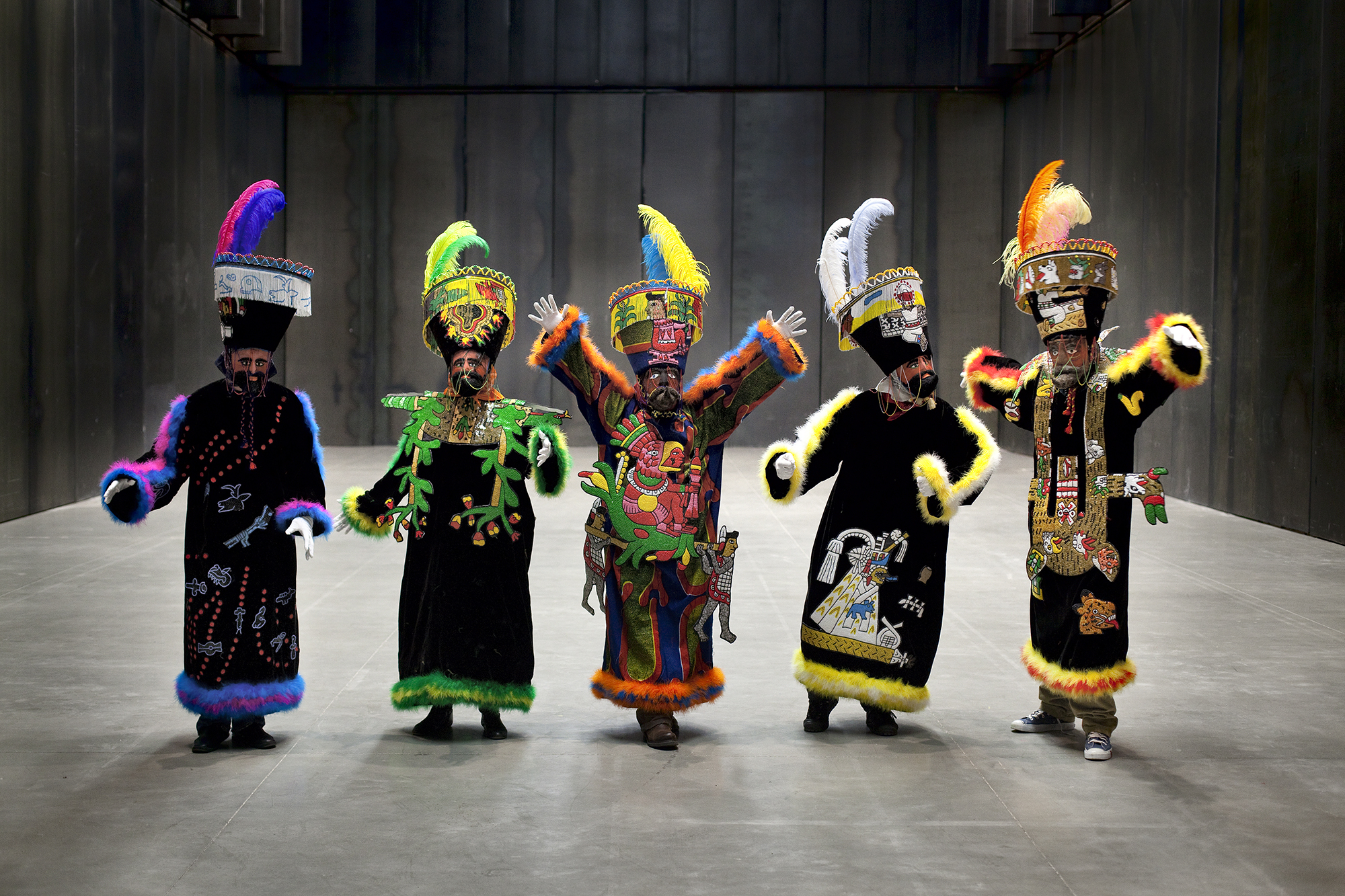
No acabarán mis flores, 2012
Five embroidered Chinelo costumes: bead Embroidery, velvet, feathers, cotton fabric, masks.
Performance, Matadero Madrid, Spain 2013
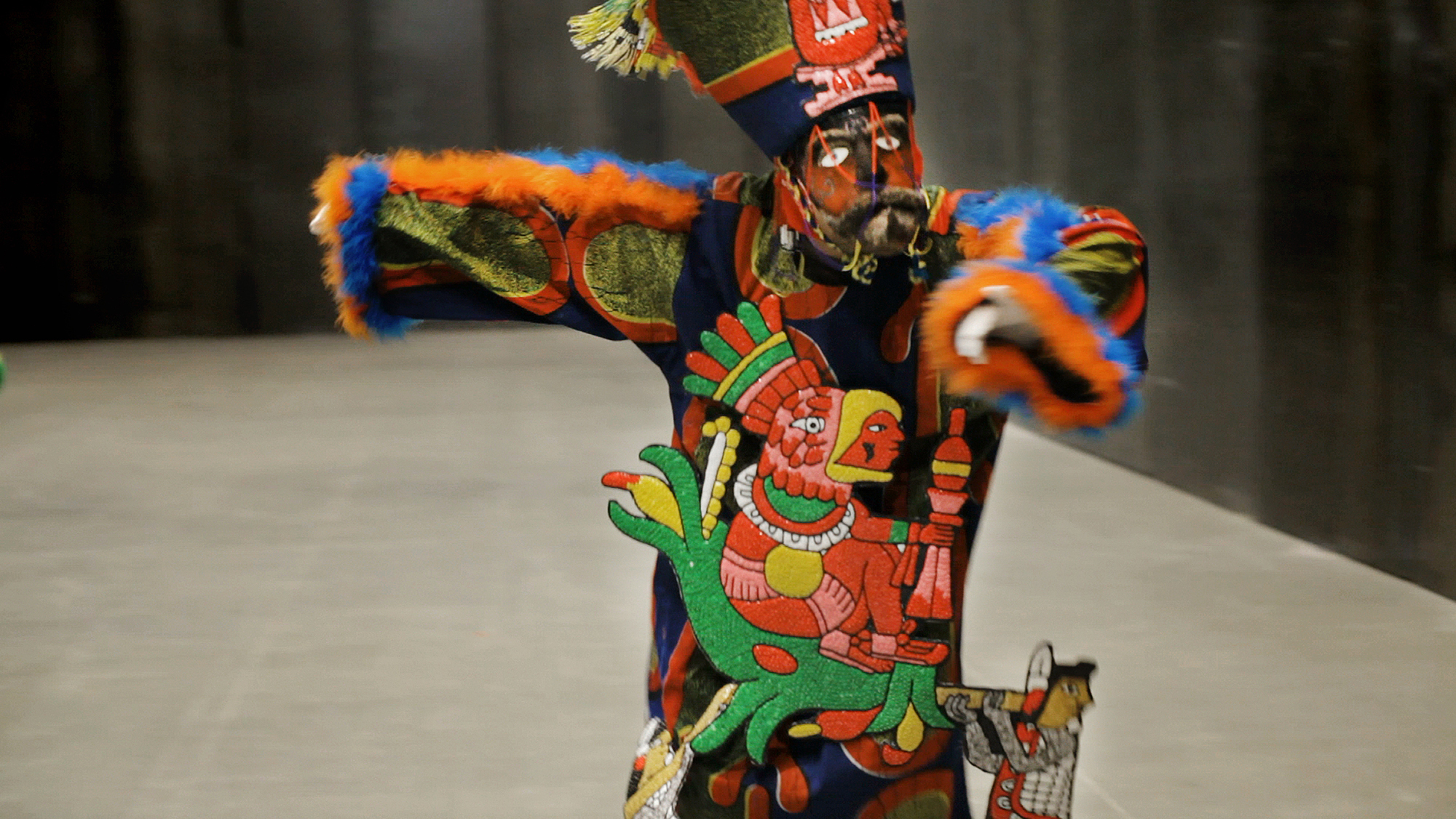
No acabarán mis flores, 2012
Five embroidered Chinelo costumes: bead Embroidery, velvet, feathers, cotton fabric, masks.
Performance, Matadero Madrid, Spain 2013

No acabarán mis flores, 2012
Five embroidered Chinelo costumes: bead Embroidery, velvet, feathers, cotton fabric, masks.
Performance, Matadero Madrid, Spain 2013

No acabarán mis flores, 2012
Five embroidered Chinelo costumes: bead Embroidery, velvet, feathers, cotton fabric, masks.
Performance, Matadero Madrid, Spain 2013
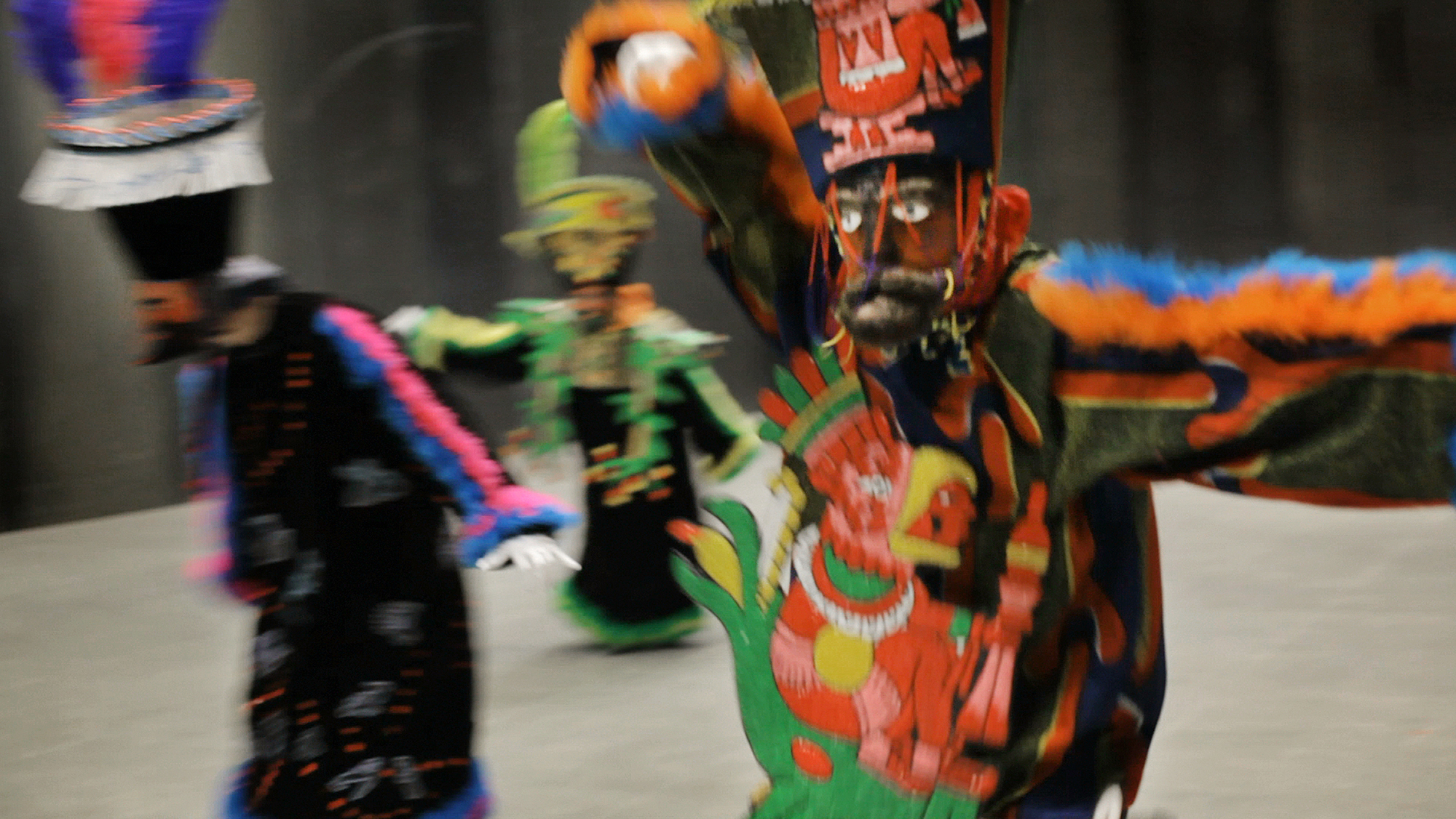
No acabarán mis flores, 2012
Five embroidered Chinelo costumes: bead Embroidery, velvet, feathers, cotton fabric, masks.
Performance, Matadero Madrid, Sapin 2013
Related publications
